Photo
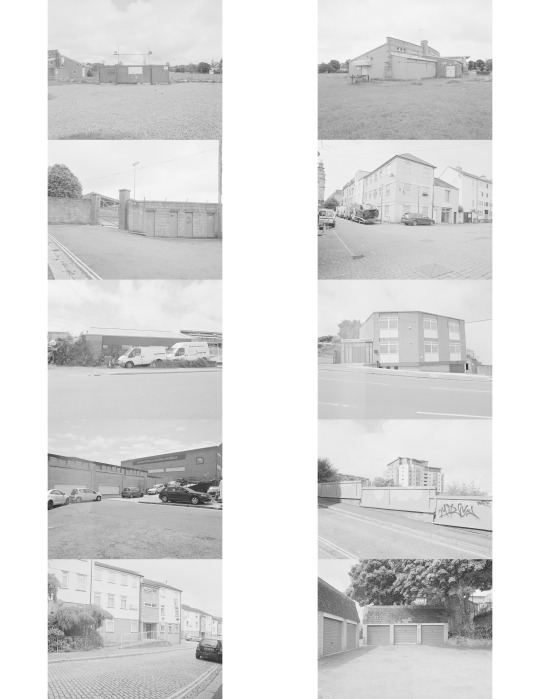
301 - Epochal Territories - 7/6/2022 Shoot #5
Time is an ever-present factor in life. There isn’t enough of it, but it is infinite. But - most of the time, if not all of the time - it is always running out. Deadlines need to be met, seasons pass, days whizz by. All of a sudden, it is June and everything is looming. The deadline is approaching quickly, I have to find and move to a new house and tie up any loose ends. You say you can buy time, but it isn’t a currency.
This would mark the end of the shooting for 301, which in my opinion has been less than fruitful. Time, again, is a factor in this. Because of the deadline extension for 201, I had 8 weeks less time on 301 than I originally wanted. This meant that before I had even started 301, I was already behind. Of course this wasn’t my fault, but it meant that I had to hit the ground running.
This was the last shoot for 301, and it was a spur of the moment wander around to Stonehouse, around Union Street and ending up towards the Barbican. It was a warm early summers day, and carrying the Mamiya RB67 around my neck was like trying to march with an anchor attached to my neck. Whilst it meant I could have it ready at all times, it also meant that I had a constant weight around my neck, and the rubber strap causing a horribly sweaty rubbing sensation on the back of my neck.

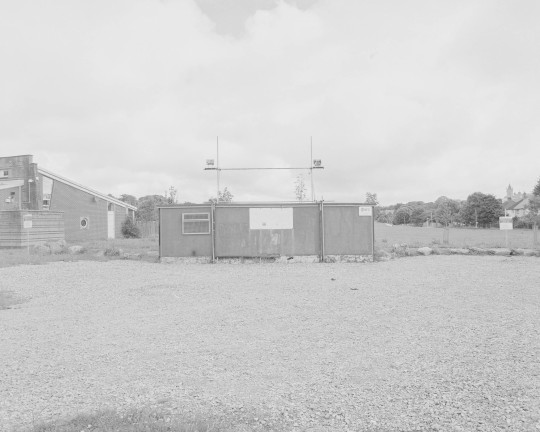
The shoot started with two shots of a sports club building, which seemed to be either in disrepair or abandonded - either way it wasn’t appealing. As usual, the RB was paired with the 50mm F4.5, offering a wide angle perspective which suits the 6x7 format and my style of photography. The bottom shot works a lot better for me, as the straight on, horizontal lines seems to favour this lens, in comparison to the above, 3/4 style of composition.

The gates that open towards another football/rugby club in Devonport. There is a sign on the wall that states ‘MOD Property - Keep Out’. There has always been a reoccuring theme of military presence in my photos, which I like to keep in as a subtle nod to instilling fear and control within society.

This was an image that I wanted to be good, but I couldn’t get the angle right and ended up being partially wonky. As explained earlier, you can really see if you are a few degrees off zero’d, as the wide angle exagerates the perspective. As much as I tweaked it, I couldn’t get it to how I wanted it to look.
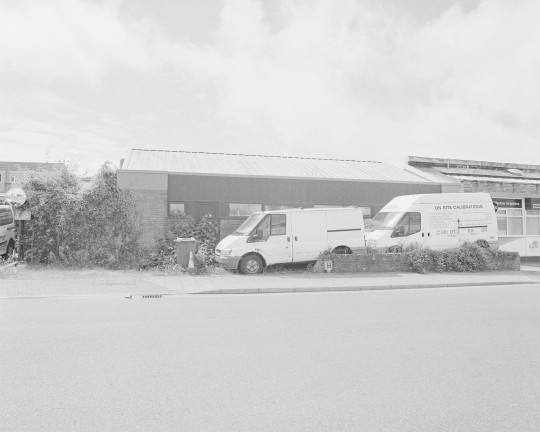
Another walk, another van laid to waste. It seems to be another reoccurring theme to document vans parked that seem to be tired and listless. Perhaps it’s a metaphor for working hard and burning out within modernity. Purely speculation and guessing, or just making an excuse.

I like to take care of my photographic equipment, and I tend to to all of my own servicing if and when I can. I have known for a while that the light seals on the RB need to be replaced at some point, but it had been put on the back burner. This was an incredibly sunny day, and the light was relentless. So much so, that the light managed to get through the buggered light seals and cause light leaks on some of the negatives. This can be seen on the left quarter of the frame, showing in the last 50% of the roll. After some thinking, I decided to still use some of the images, purely because of the falibility of film and also being human. I have mentioned before that we are becoming more and more robotic in 101, and I enjoy it when things don’t go as aspected and aren’t always pristine and perfect. It shows that things are completely fallible, just like us.
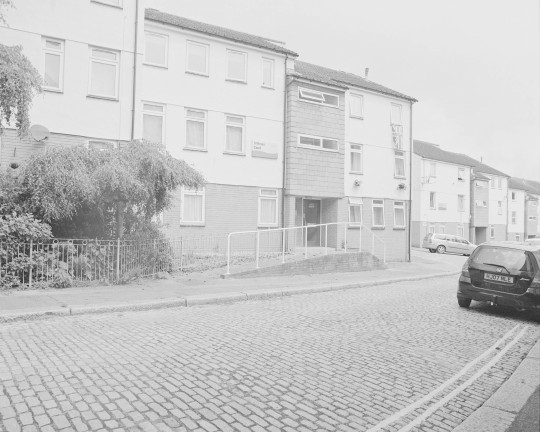
I really enjoyed the juxtaposition of the cobbled streets and the mid-century council flats. Sprinklings of the historic with a touch of the modern. Plymouth is covered in these sort of scenes, and always a mish mash of mid-century Brutalism, Modernism, historial and Comtemporary achitecture.

Finally, the last shot of 301. Ending with a set of garages composed horizontally and face on towards the doors. You can still see the light leak on the left side of the frame, but I feel that it blends in fairly well and nuances the image. I always think of Lewis Baltz’s work when I shoot straight on, as he mostly composed that way and always seems to be stark, imposing and somewhat unsettling. It is almost like this area is staring you right in the face.
A coda. The shooting stage of 301 has come to an end, and it has been rather disappointing. I had such grand ideas of shooting large format, travelling across the county and documenting all manner of scenes, but it didn’t end like that. Time wasn’t on my side, and working full time whilst have a few hours within the week to shoot, develop, scan and edit has been extremely difficult. At the time of writing this, I have been moving house, caught C-19 and trying to juggle the MA. It has been a rough journey trying to make sure that all bases are covered and keep operations running smoothly. I would be lying if I said I’ll be sad when it’s all over, but I am going to be glad when it is.
I didn’t shoot as much large format as I wanted, and stuck the the trusty RB67 to shoot the vast majority of this portion of the project. As much as I like large format, I simply needed more time to properly delve into the system if I wanted to results that I was looking for. I shall continue to use the system after the MA when I can take my time with it, and not be constrained to a looming deadline. I also feel that the subject matter of the work and amount has also been subpar. I am not impressed with that I have made and wish that I could’ve done better. Perhaps in time I can shoot what I want to shoot and not be worried about it having to be complete by a certain time. I suppose I’ll have to find out.
0 notes
Photo
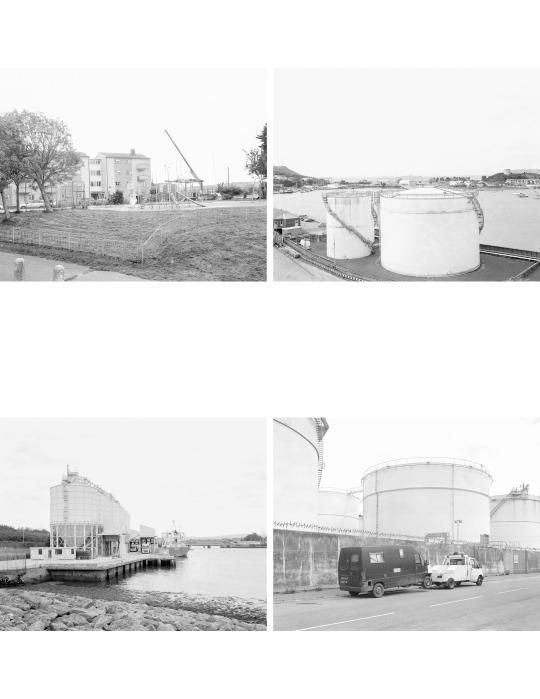

301 - Epochal Territories - 17/5/2022 Shoot #4
Time. Why does it always run out when you need it? Something I have noticed as I get older, is that time seemingly gets quicker. I remember people saying this when I was a lot younger, and I didn’t entirely believe them - surely it goes at the same rate? Well, yes, but I think it is perceived or experienced differently as one grows up. Now that I am an ‘adult’, I can now say that those people were right. Time seems to fly by and doesn’t stop for any vegetable, animal or mineral. I have recently fallen in love with large format photography, producing massive negatives and incredible detail. It is the most pure form of photography, putting the photographer entirely in control with how the image is made. But, it is an incredibly long and limiting process. So much so, that I am thinking of reserving large format for certain locations, rather than it being my main process of image making. This shoot confirmed this.
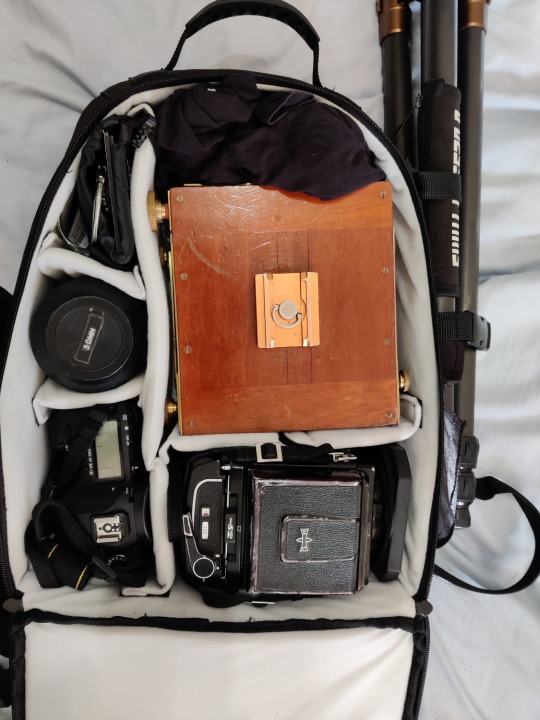
I brought along with my the Gandolfi Precision, Mamiya RB67 w/ 50mm F4.5 AND Canon 5DMKiii w/ 40mm F2.8 STM. My fully loaded bag was deeply apparent when it was placed upon my back. The RB was loaded with Ilford XP2, and the Gandolfi with Fomapan 400 respectively.
4x5
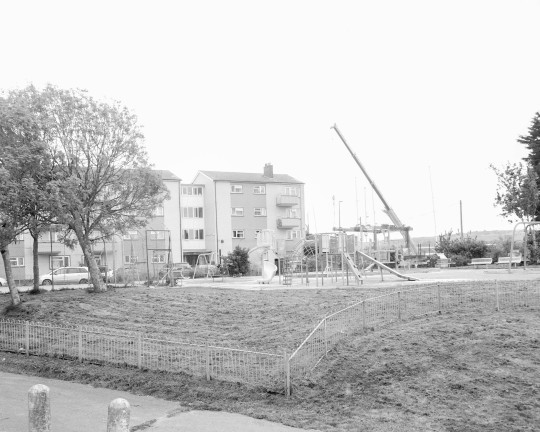
First up is the large format images. Taken on Commercial Place looking towards Artillery Place, and the housing estate and its playground. It felt rather odd to be photographing a playground in front of a housing estate, but there was something that I enjoyed about this composition, and the stillness of the playground and ensuing surroundings.

Following the South West Coastal Path towards Cattedown awards the walker with a slew of industrial architecture dealing with gas and aggregate works. These areas always have a timeless, hauntological theme to them. Hauntology is something I research previously in my BA, but is becoming more and more apparent in my work. Despite living in a hypermodernity society, there are elements of the past of what could have been. The future seemed so bright, but it transpired to be dysmal and ridden with malaise instead of the utopia we thought it would turn into.
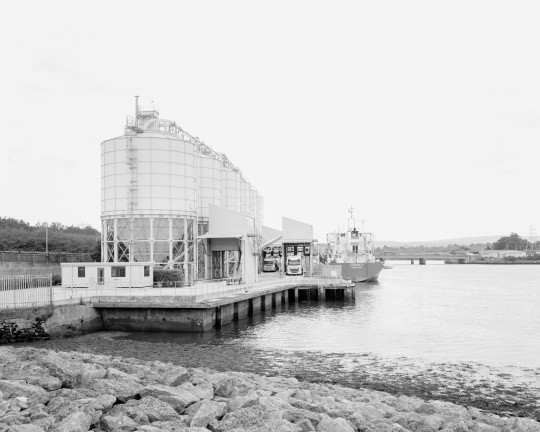
The detail of large format is shown in this image. Small details can be seen in the trucks and architecture of the silos (when it isn’t uploaded on Tumblr and compressed). Concrete is made and exported here, providing the local economy and nationwide with materials to make drab and characterless office blocks.

A van is parked up whilst being towed by a Ford Transit. Perhaps one of my favourite photographs taken on large format. The horizontal lines are perfectly alinged, the subject in the foreground are centralised and the tonal range of the film really works for me here. The detail of the large format negative is again outstanding - nothing I have experience before, even with digital cameras.
A coda. Large format is an extremely exciting photographic medium for me. It is completely manual, with no assistance from the camera at all. I like that I have to tell it what to do and how I want it to act, putting me in complete control. Digital cameras are often bloated with 8 million focus tracking points and colour space modes - I just want to tell the camera the settings I want and take it. It is possibly the most pure form of photography one can experience, just stepping short of making glass plates or daguerreotypes. The only limiting factor to large format is the fact that you are severely limited to how many images you can take in a single go. A film holder can take two sheets of film, and I have two holders. Four photographs for the entire shoot forces you to make decisions on what works or not. Digitally, you would shoot and shoot until the battery ran out or the SD card was full of thousands of RAW files that would end up bloating your harddrive. Being severely limited to this extent is what I would call, a creative limitation. However, as much as I like being creatively stimulated and limited, perhaps it is too limited for how much I want to create. This wouldn’t be a problem if I had a car and could use a changing bag on location, but I don’t have a car and that would ruin the point of a walking practice - and I don’t want to be a photographic sherpa.
120

Moving to the Mamiya RB67, paired with the 50mm F4.5 (23mm equiv). I loved the constant curve of the road contrasting the angular roofs of the units surrounding it. The juxtapositiong of the lines and the wide angle of the 50mm makes for an interesting shot, as it manages to bring it all in without it seeming overly distored - which can happen when things get closer to the lens.
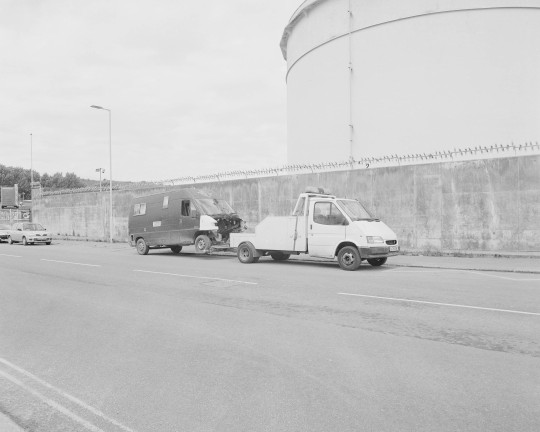
Another angle from the van on van action, showing the front portion of the towed van. Here, you can see the difference between focal lengths with large format and medium format. The Gandolfi has a 135mm (45mm equiv) and the RB67 as above, 50mm (23mm equiv). The 45mm equiv on the Gandolfi is more of a standard focal length, mostly what we would see through one eye. However, both eyes together would be around 22-25mm - strangely similar to both lenses that I had with me.

I enjoyed this peep into the aggregate grounds through this dusty tree-laden entrance. The ground was covered with off-white dust and constant beeping of reversing heavy goods vehicles. I had to be quick as there were a lot of workers walking around, and I really wanted this shot before I got shouted away.
A coda. It is always worth bringing another camera with you just in case you find more shots than anticipating. The RB67 does a good job at this, despite the fact that it is the same weight and size as an anchor. The wider focal length also works well (for some scenes), especially scenes that are minimal and uninterrupted across the frame. It is also interesting trying to compose with a waist level finder at a wide focal length, as you can’t always tell when you’re not completely straight horizontally or vertically - it takes a bit of getting used to when you are out of practice. But as always, the RB worked well and the film performed as it should.
0 notes
Photo

301 - Epochal Territories - 10/5/2022 Shoot #3
Previously, I had mentioned that I would like to return to Western Beacon when the weather had improved, and the seasons had matured. When I first came to Western Beacon in mid-April, the fog pretty much wrote off the entire shoot, as my vision of photographing Ivybridge and Plymouth from the Moors had been squandered by the murk. As time progressed - and I actually had the time in-between organising solicitor meetings and paperwork - I finally made my way to this area again when the weather was a lot more respectable.
This time, I had packed a lot lighter as I wasn’t intending to spend the entire day on the Moors. The RB67 was left at home, but I brought along with me, my Canon 5DMKiii paired with the 40mm F2.8 STM to document what I was doing, for some higher quality behind-the-scenes shots. The Galdolfi came with me again, along with the back breaking tripod. I brough two film holders loaded with 2x sheets of Fomapan 400 which was developing in Ilford ID-11 at 1:1 dilution for 12 minutes, at 20 degrees.

Firstly, I rather enjoyed using the 5DMKiii as a BTS camera, as it creates professional looking images (as intended by Canon), and something a bit nicer than just pointing a phone at everything. It somehow makes it mean a bit more when its taken with a ‘real’ camera. Here, the Gandolfi Precision is pointing towards Ivybridge/Plymouth.

Is it foggy? No. Scanning with the Flextight made it look partially foggy, but I am quite glad about this as somewhere along development, bubbles had formed onto the emulsion and had left visible marks in the highlights. Somehow, they’re masked when the scanner ran them through, and this is with minimal editing of the levels to bring out just enough highlight detail to not show them. And thanks to Tumblr’s compression, not much would be visible anyway.
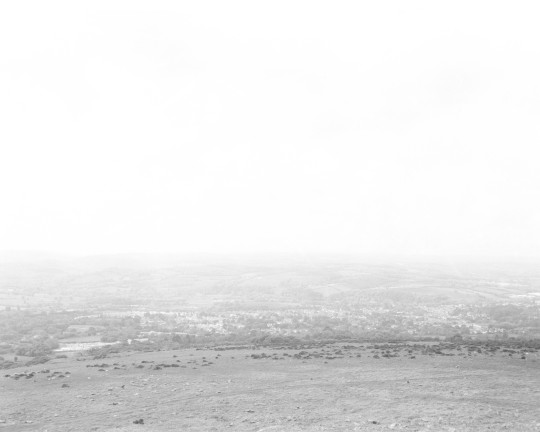
Secondly, looking more towards Ivybridge. There was a lesser amount of marks on this image, but still enough to be visible when looking through a loupe on a light table. Again due to compression, not much of the detail is visible from this 2000DPI scan (9166x7333px). Whilst the fog wasn’t appearing, there was another weather issue: huge gusts of wind. I was glad that I could see the view, but the sight of the Gandolfi wobbling in the wind worried me, as I wouldn’t be able to hide much camera shake with a 4x5inch negative.
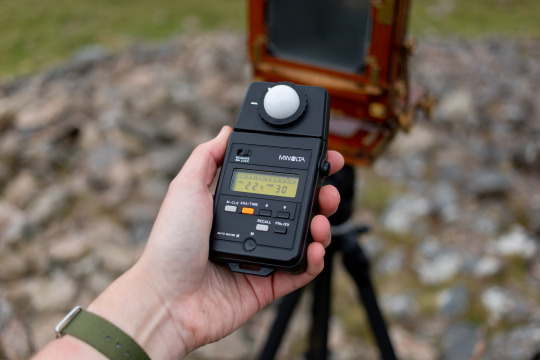
Each shot was metered individually with my Minolta Auto Meter III, and in the light was a consistent F22 at 1/30s, 400asa. This was a good thing, as on the last sheet of film, the Minolta decided it didn’t like having any charge in its battery anymore and refused to do its only job.

A coffee break was in order, as I had walked up near vertical hills to get to the location with a 10kg rucksack on a marginally warm May morning. I nestled myself in the cairns and sipped at my pipping hot drip-filter coffee, looking at the endless hills...and the A38.

I also brought along my Tascam (I packed lightly?), to record the sounds of the area. Whilst wind gently blew the microphone, birds chirped loudly and the faint sound of road noise and construction could be heard again.

I moved to a different spot not far from the sheltered cairns, to one of the peaks of Western Beacon, where I ate my ham and emmental. This would be my final position, and created two images that I really enjoy.

Looking towards Hemerdon Mine, or Drakelands Mine, or even Hemerdon Ball Mine. This is home to Tungsten West, a key site for mining Tungsten within the UK, and the world. But thanks to the wonderful compression, the detail of large format is lost on this digital platform. What goes through my mind is how the land has been altered over time by man, and how it isn’t a new thing. We look at Dartmoor as an amazing natural beauty, but it has been fettled and changed by our ancestors. The bronze are saw mass deforestation of Dartmoor, and the industrial revolution then saw the Moors littered with mines, eating the landscape. Nothing has really changed, apart from how the land is used. It is no secret that the land we walk on is living on borrowed time. Climate change is something that has been known to scientists for decades, and yet only within the past 20 years has been within the narrow vision of the public - with some potentially saying that we should’ve done something about it when it was first noticed. We are changing the land we walk on and the air we breathe. It is terrifying to think what is to come.
A coda. This was much more enjoyable in comparison to the previous shoot on Western Beacon, as I could actually see what I was doing. And as a bonus, I was able to get sharp photos with information on them, instead of a foggy mess with little detail. The only downside was that it was incredibly windy, causing some blurring on the negatives (which is only really visible if you’re looking very very closely). Another downside is large format in of itself. It is extremely limiting with how many images you can take, which would be fine if I could take my time with this project. I am beginning to think that it isn’t viable to shoot entirely on 4x5 film in the time that I have left, if I can only shoot 4 sheets at a time. Where I can, I have been shooting the Mamiya RB67 along side to bolster the shot count, but I can starting to think that it might be entirely more beneficial to shoot the RB over the Gandolfi, purely down to the fact that I can shoot 10 shots instead of 4, and carry more film with me if I wanted. As much as I have fallen in love with large format, perhaps it is too slow for this amount of time.
0 notes
Photo

301 - Epochal Territories - 21/4/2022 Shoot #2
Going further afield...how further can that be? Previously, I had mentioned that Plymouth as a location has been exhausted, and felt bored of being around the same locations. Completely unrelated to that, me and Harriet decided to get away for a few days to recharge the batteries after a hectic few years. As a couple, we have never been able to get away due to our degrees, COVID lockdowns and working. We managed to find some time and we decided to go to Cardiff, a place I have never been to and a country I have never visited. Wales has always interested me, because of it’s contrasting landscapes of moorland and industry. Naturally, I found an area that I was interested in via Google Maps whilst looking for places to eat, which was Celsa Manufacturing UK.
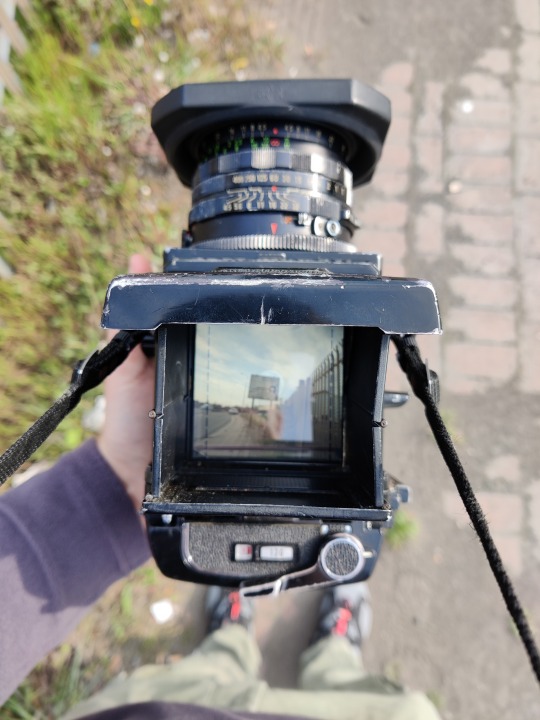
The morning of 21/4/2022, a couple of hours before we were going to check out of our Premier Inn, I walked to this area with the Mamiya RB67 around my neck, loaded with a roll of Ilford XP2. The route was rather strange, as to get to this area (Splott), I had to walk by an busy A-Road being pelted with dust kicked up by constant HGV traffic. The walk was worth it, as I was rewarded with a fantastically bleak area, which was partially marred by heavy traffic.
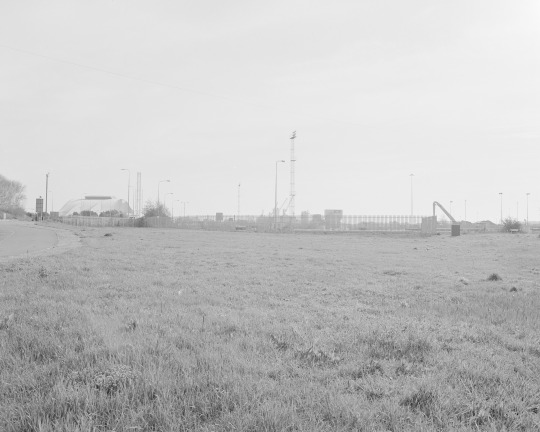
The roll started by Pierhead Street, looking out to Roath Docks which houses Hanson Aggregates and EMR Cardiff, a scrap metal works. The 50mm on the RB67 is incredibly wide for 6x7, but perfectly suits my style of landscape photography, as it offers a wide POV style frame from where I am standing, and the detail of the 6x7 negative means that despite areas being further away in comparison to a longer focal length, they are still visible and detail is retained.
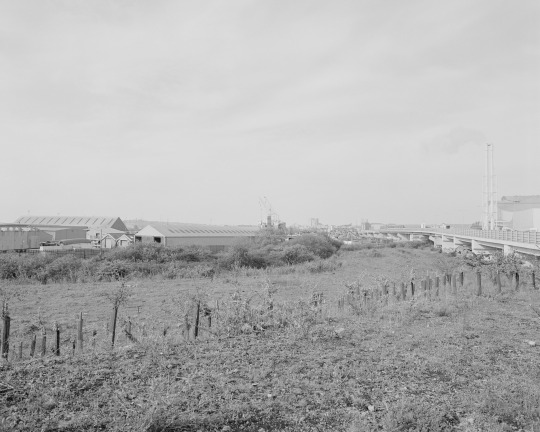
This is the view from the other side of the A4232, looking towards the other end of Roath Docks. Walking across the overpass on the right, I was struck with the notion that it was the most non-place area I have ever visited. It felt like a never ending road, with the wall just above my eye-line, surrounded by concrete and road debris constantly blown into my face, and upon returning, my ears were filled with black dust. A crane claw was in operation at EMR Cardiff, shifting masses of scrap metal creating large crashes and rusty dust emanating from the docks. I was concerned by the constant traffic, as I was worried that it would congest my imagery.
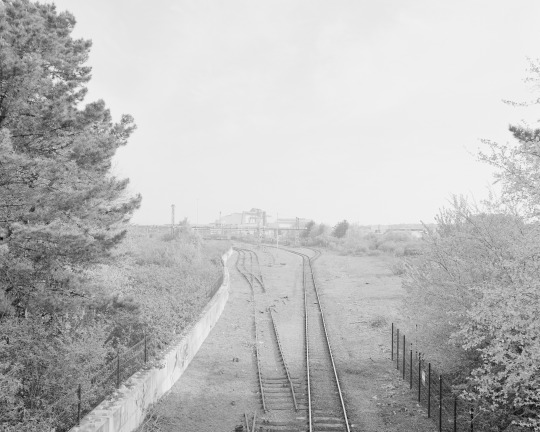
Ocean Way, looking towards Celsa Manufacturing UK. The train tracks and gates creating leading lines which end up at the main processing plant of Celsa, which deals with steel manufacture for industry. The roads running adjacent to Celsa consists of constant HGVs going to the industrial estate and cars driving to a Tesco further up the road. Class 09 locomotives shunt around stock, with Class 66 locomotives moves stock from the plant to the mainline. The trees create a juxtaposition of the industrial setting, with the trees surrounded by litter and other human detritus.

Opposite Celsa, is a water treatment plant. This was just off of the main road, and was quiet enough to take a photograph. I was constantly looking out for traffic and security - anybody to discourage someone with a camera taking photographs of something that people don’t want photographed. This area was incredibly fruitful, and I wish I had more time and more film with me, but I was limited with time and a single roll. It was the kind of area which I could’ve spent a day walking and taking photographs.
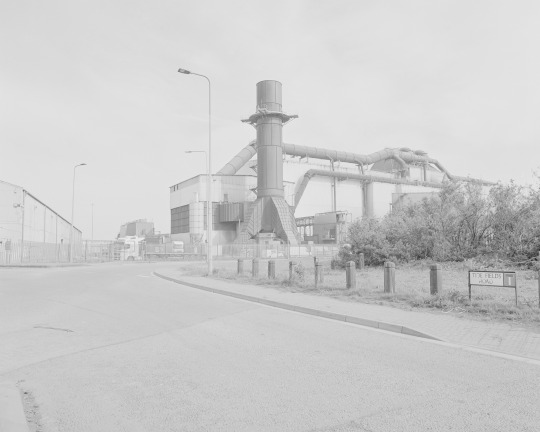
Celsa Manufacturing UK. I had intended to walk further up the road, as opposite the main site (on Google Maps), looked as if it was full of slag heaps. But the traffic was constant, and I had to wait at a crossing for five minutes just to get this shot. Again, if I had more time I would’ve been able to get the shot I wanted. I have never really been in the vicinity of a plant like this, but I found it fascinating walking past and peering through the fence into the plant. Celsa is the biggest producer of reinforcement in the UK, and one of the largest manufacturer of longer steel products. Yet despite it being a large producer of steel, it has some incredibly bad reviews from lorry drivers, with mostly Romanian and Polish drivers complaining of extremely long waits, terrible waiting areas, poor road quality and drivers from the UK getting instant access to deliveries instead of following a set itinerary of drivers, causing those from the mainland to feel alienated. I cannot say that I am surprised, but it shouldn’t happen. One would’ve thought that an industry as big as this would respect all clients and workers, but favours some. I am only a photographer, but I feel bad for those having to weight several hours when others get fast track status, when one would assume that some steel deliveries would be going back to mainland Europe and would have to drive further in comparison to internal deliveries.
Adjacent to the plant is Splott Beach, an area of outstanding unnatural beauty and often attributed to asbestos and waste. This was an area that I also wanted to visit, but due to the traffic congestion and no way to cross the road to the ‘beach’, I was unable to get to this location. Again, if I wasn’t limited by time, I would’ve been able to visit it, as from the muddy beach, one can see the industrial structures which I found interesting from a compositional, and photographic point of view.
A coda. Shooting in another country has cemented the idea that Plymouth - to me - is completely exhausted as a location. Half a decade of shooting in the vicinity of Plymouth has left me wanting more, and shooting in Cardiff has given me the urge to travel further afield. Visiting new locations is obviously going to me more fruitful, as you’re seeing locations with a fresh eye, instead of knowing a place like the back of your hand and knowing what to expect. It has given me the idea to return to Wales in the near future, by catching a coach and staying a night in a hotel to cover certain locations. The Megabus seems to be around £40 for a return in comparison to just under £100 for the train, which is only around an hour quicker (if it isn’t delayed). Hotels seem to hover around £50 a night for a decent room which is worth paying for instead of a hostel if you prefer creature comforts like myself. I am seriously considering doing this, as it would give me a fresh view on new locations which I have never explored, instead of trying to cover the same location at a different angle. This is something I would like to look into and get sorted before the end of the academic year in July, possibly in May or June. I am incredibly excited in travelling to new locations, but my main concern would be affording the travel. I hope that I can get a bargain and get myself to sunlit uplands.
0 notes
Photo

301 - Epochal Territories - 12/4/2022 Shoot #1
Shooting has commenced for the final hurdle of my postgraduate degree. It seems incredible to me that it was two years ago that I was finishing up my third year work of my undergrad during the first lockdown in 2020. With the MA coming to an end, it is time to start the end of this chapter of my life.
Large format photography is something that I have delved into, and something that I have wanted to do for a very long time but put it off by making excuses, despite it being recommended for years by lecturers and professional photographers that visited during my degree. I am glad that I have, because it is a beautiful process which is as manual as photography gets. Now is the time to push the boundaries of 101 and 201! Where can I go, and what can I shoot that is different?
Leaving Plymouth is the biggest one, because I feel that I have exhausted the initial area of the city and the outskirts. I have shot these areas for the better (or worse) part of half a decade, and it is wearing thin. To start off, I left Plymouth and got on a train to Ivybridge, with then a hike to Western Beacon and Butterdon Hill on the southern most point of Dartmoor. It boggles my mind that it is so close to civilisation.

My bag was packed to the brim of equipment, weighing in to around 11kg including the tripod which isn’t shown here. The red portion if the Gandolfi and the lens, with the Gandolfi wrapped up in a neat neoprene camera wrap I bought on Amazon for £8 for a pack of three various sizes - one of the best purchases I’ve made. The green portion is the Mamiya RB67 Pro-S, with the Sekor-C 50mm F4.5 - a recent acquisition which is my favourite way to shoot 6x7. The 50mm is equivalent to around 24mm to full frame, and creates some incredible images. The blue section is the Minolta Auto Meter III, which is another great purchase I made a couple of years ago, and performs accurate incident meter readings. I also brought two film holders for the Gandolfi, loaded with four sheets of Fomapan 400 (which cost me £40 for 50 sheets!). The RB67 was loaded with a single roll of Ilford XP2 Super, which I have already waxed lyrically about during 101.
The reason for this shoot was because I stumbled across the view from Western Beacon, which overlooks not just Ivybridge, but Plymouth in the distance which nicely juxtaposes the ‘natural’ setting of South Devon. However, when I arrived at the train station in Ivybridge, it was immediately apparent that this wasn’t going to happen on the day, because it was thick fog with around 75ft visibility. Despite this, I still managed to get some images which may or may not work its way for 301.




Firstly, the four 4x5 images taken on the day. As one can tell, it is extremely foggy. Focusing was incredibly difficult even with a dark cloth, which would’ve been OK if I had stopped down more, but I was also aware that the lens sticks when it gets to around 1/10th as previously mentioned. I shot at F8 for the most part, but I wish I had went to around F16-F22 for a larger depth of field. The fog does add a certain mystical aesthetic to the images, but it isn’t something I was looking for. I developed the Fomapan 400 in stock ID11 for 7 minutes, which created a decently contrasty negative. The fog made it hard to scan and get detail, which is the main reason for shooting large format. However, I am glad that I brought the RB67 along with me as a back up camera.

I am more proud of the images from the RB67, and questions why it is that I am shooting large format entirely. Despite the RB67 being around 3kg, it is a lot more portable in comparison to the Gandolfi and can take 10 images on one roll. The image area is around half of 4x5, but still contains an amazing amount of detail thanks to Mamiya’s world class optics. It was worth lugging these cameras for 18000+ steps, mostly up steep climbs.



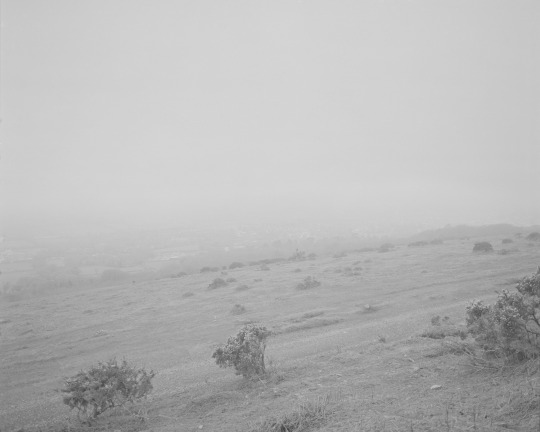
What I enjoyed most was despite the age, was the influence man had on the landscape. Dartmoor was extensively mined and deforested during the Bronze Age. This area is covered in granite cairns, slag heaps and concrete beacons to mark tors. The final image in the above set is what I had envisaged (without fog), as one can see parts of Ivybridge and on a clear day, Plymouth would be visible. I do like the faint lines of civilisation, but even as far as Butterdon Hill (second from the top and around 2 miles from Ivybridge), road noise from the A38 can be heard, and reversing lorries from the housing estate being made near the train lines below. Even though I was wandering around the moors in the fog, I was reminded that I wasn’t far from modernity despite the illusion that I was alone in the wilderness. If it wasn’t for the noise of the traffic, I could’ve believed that I was completely isolated, separated from everyone and everything. In a way, the fog made me feel disconnected from the world, and was acting as a smoke screen from the world, allowing me to dissociate from the world around me and focus on the small surface area of moorland I could see.
A coda. This shoot wasn’t what I initially wanted for the first shoot of 301, but I cannot control the weather and these things happen when you shoot landscapes - nothing can go right all of the time. But, there is a certain quality to the fog which could lend itself to my work, but this entirely depends on what is created from this point. I did enjoy going on a hike to new places, which is something which is definitely needed, as Plymouth does feel exhausted. It makes me think that I need to visit locations further than the vicinity than the city.
0 notes
Photo

301 - Epochal Territories - First 5x4 Experience*
*with film instead of paper
The time came to finally shoot large format properly, without using cut up pieces of darkroom paper and being limited to ISO 6. I have waited for this moment for a long time, and I was finally ready to dip my toes into the world of large format photography. This is something that I have wanted to do for a long time, but always put it off because boiling it down, I just wasn’t ready to commit to this format. I was comfortable using 35mm and 120, but craved the detail, precision and effort to make an image with the most manual of cameras.
I was ready, and had extensively researched what to do, but really it is common sense once you have used a camera for years. Looking back at it, large format is probably the easiest format of film to use, despite the huge size difference in comparison to 35mm, with 5x4 covering thirteen times more image real estate. With this, comes a large difference in depth of field as well, with F5.6 in 5x4 equating to the same DoF as F1.2 on a 35mm camera. This means stopping down the lens to around F16-F22 to get more on focus, and depending on the film speed would result in slower shutter speeds.

Image by Aaron Lovelock - Hasselblad 500C, Sonnar 150mm
For my first venture, I used two sheets of Fomapan 200 kindly donated by good friend, flat mate and MA colleage, Aaron Lovelock. Aaron has said for years that there is Fomapan 200 in the freezer ready for my to shoot - and that time came. Loading the holder of a 5x4 camera seems daunting, but is rather simple. In complete darkness, one has to feel for notches on the film, which will correspond to the top right, or bottom left of the holder. The film would be slotted in between grooves on each side of the holder, and the darkslide would cover the film when ready to expose. Focusing the camera is also rather simple, as you focus when the lens is wide open with a dark cloth over your head (or an old black PCA branded t-shirt like I did), and then stop down once you are ready to take the shot. The camera is entirely manual, and you have to call the shots in terms of metering and focusing. There really is nothing like it, and it is welcomed. There are no distractions like focus points, beeps, batteries to charge or random useless settings. It is just a box with a hole.
We went to the top of the Mayflower Street Car Park, just to check that the camera works. I used the Gandolfi Precision, a camera made by the Gandolfi brothers in their workshop in Peckham, South London. Gandolfi Makers ran for around 100 years making bespoke, handmade large format cameras and tripods. which is becoming a lost art. These cameras are incredibly sought after and welcomed by collectors. This particular copy has been a part of Plymouth College of Art, but has been archived for years, much like the Nikon F3 I purchased last year. Dave Symons, the Studio Coordinator, PCA Legend and work colleague, said to me that he doesn’t want students using because they are so rare, but is happy for me to look after it for a while as I am trusted. I chose to use the Schneider Xenar 135mm F4.7, equivalent to around 35mm/40mm to the full frame format. This is a decently performing lens, often used on large format press cameras such as the MPP Technical. This partially rings true, as the lens is on an MPP board which fits the Precision. But, how did it go?

Outstandingly well (mostly). I didn’t realise that I had my meter set to 160 ISO, so it had already metered at 1/3 stop slower than anticipated. Something else that I forgot was that the lens (as most old syncro shutters) sticks at slower speeds. This is sometimes hit and miss, but this is due to the slower speeds being governed by a separate piece of clockwork, and over time the regulator for the speeds wear out, or get stuck with old lubrication. The first shot didn’t matter too much, but the second exposure was far too gone. At F16 and 160 ISO, I was looking at 1/8th of a second. I set the lens to 1/5th of a second, and this turned into around three. And to add insult to injury, I completely forgot to shorten the development as the film was unintentionally pulled, and developed at a standard exposure. Above was the first exposure, but the second didn’t survive as well, and is incredibly dense with very little detail. They were scanned with the Imacon Flextight X1 at 1200DPI, which for large format creates a huge file with immense detail - it is exactly what I have been looking for. Sadly, despite the X1 being a formidable piece of scanning equipment, the best result was something that looking as if it came from the Gameboy Camera after some tweaks, so it was better unscanned.
What I learned about large format is that it is incredibly easy and refreshing. Since my father died, I haven’t really felt like picking up a camera as nothing felt fresh to me. Shooting large format has been a breath of fresh air, and subsequently bought a 50 sheet pack of Fomapan 400, which I intend to shoot for this project. With large format, I have complete control over everything about the image, and it really does slow down the entire process. 35mm means you have at least 36 exposures to get it right, but with large format you can only get two shots per holder, so the pressure is on, but you can take your time with the image and curate it exactly how you envisage it. I have fallen in love with the format, and it is all I can think about. Now, I just want to visit places I haven’t ventured too, set up my large format camera and take some incredibly large negatives. It is all I can think about, and once again I am excited to create work. This hasn’t happened in a long time, and I am sure my Father is eagerly awaiting to see what I create.
0 notes
Photo

201 - Epochal Territories - How Things Change
Life is, odd. Life can change within an instant and when you least expect it to. All of sudden, something will happen which will cause everything to collapse, or skid out of the control on a motorway, careen towards the central reservation and write off your car.
Christmas was originally intended to be a busy period of time to get on with what needed to be getting on with, I.E the main body of writing, photobook, exhibition and submission. Not much of that happened but I did however recharge my batteries which I did, in retrospect need. I was ready when the new year came around to go headfirst into 201. Then the worst thing to ever happened in my life, happened.
My father suddenly passed away in his house in France on January 9th, which is still a shock to me a month later - and probably will be for the rest of my life. This of course changed a lot of things which I won’t get into here, but it did delay my 201 submission due to the distressing news. My deadline was put back to March 15th which is a good chunk of time to reconsider some things about my work, and possibly do various parts which I didn’t think I would have to time to. But, what are these things?
Sound design of my exhibition is something I really want to consider. Nothing extravagant, but something playing in the background like my typical line ‘overhead powerlines humming’ or ‘fridge buzz’. This can be made with an analog synthesiser, digital audio workstation (DAW) and could be mixed with recorded sounds at train stations, city streets and various foley recordings.
Revisiting certain locations. A lot of the photographs for 201 aren’t impressive to me, often being lacklustre and embarrassing. I would like to revisit one or two locations and re-take some photographs before the deadline whenever possible.
Creating more graphical elements to place in the photobook. These featured in the book for 101, and I would like these to return. The increased time frame can facilitate this.
Speaking of which. The design of the photobook as a whole and the ‘colour’ palate. This would be inverted from the 101 submission, being mainly white with black text instead of the other way around. The photobook will also be dedicated to my father.
All viable updates to a body of work that I am not entirely pleased with. 201 was meant to be a body of work intended to improve upon 101, but I can see how it falls short of the mark. I do not hold much hope with this submission, and await 301 instead.
0 notes
Photo

201 - Epochal Territories - 20-21/11/2021 Shoot #6
This shoot was situated over the course of 48 hours, starting with three separate walks with my friend Charles, housemate and ever dear friend Aaron and my Mother, Hellyn. This would be the last shoot for 201, marking the end of the shooting period for the project. It would end up being something of a bugbear, as I feel as if I didn’t shoot enough for this body of work, despite the larger frame numbers per shoot due to the 35mm film.

The camera setup didn’t change, however. I brought with me my Nikon F3, paired with the Nikkor 35mm F2.8 (AI converted) and the MD-4 battery grip. The addition of the latter creates a rather large and bulky setup for 135 format shooting, but I enjoy using equipment that feels dependable.

This roll started on 20/11/2020 when I briefly met up with Charles for a coffee and a walk. It wasn’t my intention to shoot anything, but a few things ‘caught’ my eye if it were. It really felt more like an excuse to use a camera that I brought instead of it staying in my bag.

However, some things did show up which I did enjoy. This is the entrance to the Register Office on Armada Way. The low horizontal lines emerging from the bushes, surrounded by autumnal leaves caught my eye, especially the architectural style of the building itself. I also enjoyed the arrow on the ground of the car park pointing towards the camera, and the car park lines pointing towards the building, creating a mass of confusing lines.

I came home later, and Aaron wanted to go for a walk, so I put my shoes back on and we went towards Firestone Bay and towards Eastern Kings Battery, overlooking Millbay. I really enjoyed this mass of Rubus fruticosus overtaking the concrete posts and wire mesh fencing.

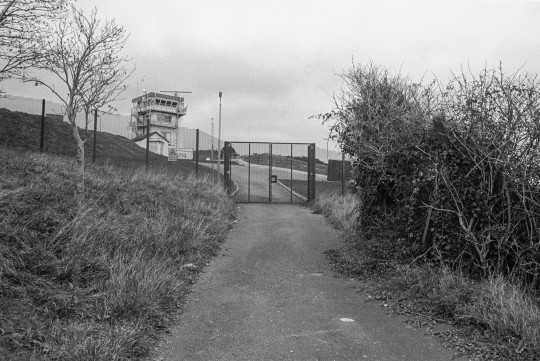
Eastern Kings Battery is a Victorian era battery overlooking Millbay and Firestone Bay. What I found fascinating was the uneasy feeling of being potentially watched, being acutely aware of the panopticism of the area. A large watch tower shown above could have easily watched our movements, whether they are or not, it is assumed they are so the actions and behaviours are changed accordingly.

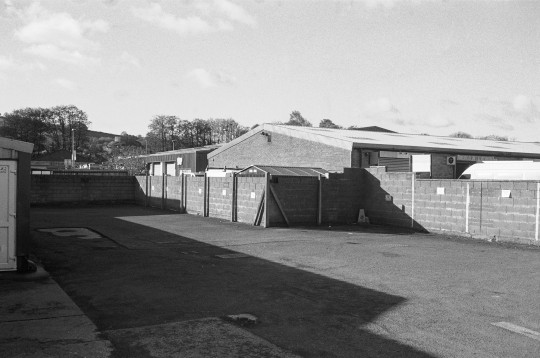

Lastly, on the next day, I visited my Mother to make sure that she was OK, as she is disabled and lives alone. I encouraged her to come out and do some photography, in an attempt to get her creating again. We walked around the industrial estate in Totnes, which on a Sunday is deathly quiet. The light was much more pronounced in comparison to the previous day. The sun was able to create contrasting shadows, and due to the sun’s low height during that time of year, extenuates them, forming long and drawn out shadows of the industrial structures. The low nature of the structures and the POV style of my photography, the buildings played upon the horizon, creating contrasts of the straight roofs and the flowing hills surrounding the town.
A coda. This was the last shoot to be undertaken for 201, which would lead to myself feeling unsatisfied about the work I had created. I am extremely aware that this isn’t the best work I have made and on the whole, I feel generally dissatisfied with the work I have produced in comparison to 101. I would like to think that this would be redeemed with a good mark and an overall positive reception. It has been difficult to work balance a part time degree with a full time occupation. I hope that as time goes on, I can plan ahead better and even get ahead of the game in terms of shooting, curating and planning how my work should be shown when the time comes for 301.
0 notes
Photo

201 - Epochal Territories - 16/11/2021 Shoot #5
Another shoot beckoned, which followed the same trend as those that came before it: load the camera with film, walk in a direction and see what happens. There is something nice about not premeditating a destination or a particular route before going out, rather taking the route as it comes as the journey is ongoing. When figuring out a route before going out, one seems to make decisions on where to go, purely on if it would be fruitful or not. More often than not, it can lead to disappointment as the location has changed over time since the Street View data hasn’t been updated since 2009.
At this point, the shooting is standard operating procedure: Nikon F3, 35mm F2.8 and a roll of Ilford Delta 400 developed in ID11 at 1+1. The resulting negatives were then scanned with the Hasselblad Flextight X1 at 3000PPi.

This route started at Freedom Fields park. This is a lovely park situated in the Lipson area of Plymouth, with an outstanding view of the sea and rolling cliffs leading into Plymouth Sound. The park is also home to a mass of dog walkers, children and what would be called either yobs, chavs or asbos. What drew me to this shot was the mixture of architecture, leading lines of the junction and the autumnal tree, shedding its leaves.

A new addition to the Nikon F3 is the MD-4. This is the motordrive grip for the F3, making it more battery dependent, but allowing burst photography and an improved grip. The grip is powered by 8....EIGHT AA batteries which can offer 4 frames per second, and overrides the two LR44s that power the body without the grip attached. It can also power 140 36exp rolls, equivalent to around 5000 exposures.

Something I enjoyed in this composition was the horizontal line curving in the background, juxtaposing the angular houses and garages. Also, the small boat parked in their driveway looking rather sparse and unused. It too contrasts it’s surroundings by being a lot whiter compared to how the houses are rendered on the film.


Closer to the Laira Depot, were these two locations situated only a few feet from each other. At the top is presumably a housing for a transformer for the surrounding houses, and below, a long and flat building mainly used as a social club for the GWR Staff Association. This building runs adjacent to the mainline and also features a pylon within it’s vicinity. Being by the mainline, it wasn’t long until a train passed which I managed to capture. If my memory serves me correctly, it was taken at around 1/125s at F8. You can see the movement of the train, but it isn’t totally blurred where it becomes unrecognisable.

The tunnel underneath Embankment Road is a typically brutalist structure: covered in water stains, surrounded by urban greenery growth and wholly utilitarian. This wasn’t designed to look nice or pleasing, it was made to serve a function and allowing traffic to go underneath another stream of traffic. A place of no significance which in turns makes it a non-place. Adding to this, it is also entirely made to transit you from A, to B, and maybe C. Stopping in a place where one is usually passing by creates an uneasy feeling.

Ending by St John’s Street and St John’s Bridge Road. Paul Inch Engine Services is a specialist in engine rebuilding and maintenance, and usually always has interesting things in the forecourt of their business. This area has been keenly documented before, but it features so many intriguing engineering and mechanical ephemera which make good subjects in these bleak landscapes.
A coda. Now, in complete honesty, this is being written a long time after the fact in February 2022. Keeping this blog up to date slipped behind during the Christmas break, and in the new year when I had the horrible news that my Father suddenly passed away. My deadline has been extended to March 15th, which is why things are being updated after the original deadline of January 25th. Remembering details from November of the previous year is a bit fuzzy, and strange to look back at when things were a different normal.
0 notes
Photo

201 - Epochal Territories - 9/11/2021 Shoot #4
Sometimes, a lull can be a difficult thing to get out of. You’re stuck in a rut and there is seemingly now way out. I felt like this since the last two rolls for this project, as they were horrendous and I felt embarrassed that I had even created such poor work at this stage. But, sometimes, a gap in the rut comes along and you’re out of it. Thankfully, this happened.
Over the past 2 weeks (as of 9/11/2021), I have started a new job at Plymouth College of Art as a Central Stores Technician, which means that I work in the Equipment Resource Centre, booking out and maintaining equipment in addition to the studios. I am usually surrounded by camera equipment all day and it is bliss. Some of the equipment is archived because it is either surplus to requirements or completely broken and beyond economical repair. Some of this equipment either stays in a box, or placed upon a display cabinet across the campus. One such piece of equipment was my holy grail 35mm camera: the Nikon F3. I inquired about purchasing it, thinking it was a bit of a tall order and it wouldn’t be possible. To my surprise, it was possible!

The Nikon F3, on location.
A quick paragraph as to why this is my holy grail film camera. The Nikon F3 is possibly Nikon’s crown jewel, due to it’s Italian design, bulletproof construction and 21 year production run. The F3 was built to last, and built to be used as a camera for professional photographers. This is the standard version of the F3, but features the DE-3 prism or HP (High Eye Point), which is better suited for glasses wearers because of the magnification. Other F3 flavours are available such as the F3P (Press) and F3T (Titanium). The F3P and F3T are related, as they share the same features such as weather sealing, no self timer/multiple exposure levers and solid shutter button. The only difference is that the F3T is made from titanium instead of brass. This Nikon also features a completely modular build, with the photographer being able to swap out the prism, focusing screen, film back and motor drive. This example was placed in a shelf for many years, and after a fresh set of new batteries and a quick clean, it was ready to shoot!
I loaded up the F3 with Ilford Delta 400, mounted the Nikkor-S 35mm F2.8 and went towards the South East of Plymouth. I walked through Cattedown, East End, Prince Rock and St Judes, collecting around 5 miles before getting back to Plymouth College of Art to develop and scan. The film was developed in ID-11 at 1+1 for 14 minutes, and scanned with the Hasselblad Flextight X1 at 3000PPI.
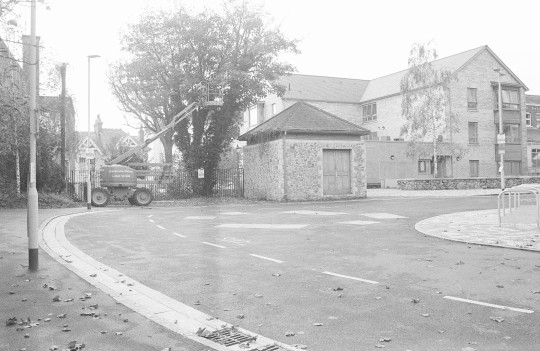
The shoot started out on Bretsonside, looking towards Martins Gate Gardens and the small turning circle. In the corner is a cherry picker which as been sat there for days, and a very leafy road. The first thing I noticed on the scan was the strange line hear the middle-left of the frame. This wasn’t on any other image, so I am not entirely sure what would have caused this. Secondly, Delta 400 is a really nice film stock. It seems to be incredibly sharp, and not overly full of contrast and with a good dynamic range.

Walking further afield around Sutton Harbour, and to Marrowbone Slip. This area features a car park and large area of overgrown nothing-land where buildings once stood, but has been bordered off for a long as I can remember. You can see the buddleia growing wherever it likes due to the plant being incredibly invasive. It can often be found in edgelands, railways, car parks and people’s gardens. It is native to China and Japan, but was introduced at some point in the 1890′s and quickly took over any unkempt land or pruned garden.


Two of my highlights for the roll, at the Avis car rental car park on Commercial/Clovelly Road. The stars aligned for me in terms of composition, light and subject matter. The quietness is deafening, and the landscape in front of the viewer is incredibly bleak and withdrawn from any human interaction - just straight lines and industrial buildings surround you as nobody else does. Even the 35mm focal length was perfect for these shots, as anything wider or narrower wouldn’t have created the same effect. There is also something about photographing gates and entrances to places which often seem forbidden. They are (obviously) a gateway to another place, often a place where general admittance is not permitted, whether it is for workmen or that place is a hazard to the public. It is also the ability to apply Schrodinger's Cat to the space, and leads one to question what is the reality behind the wall and beyond the gate. Perhaps it is better left unknown. But it is also being on the edge of a periphery or just out of bounds within the space which I find interesting, almost going back to the intrigue of the edgeland and non-place as a whole. These are spaces often found by drifting or passing through, yet spending time in them seems unnatural to the extent that they become wholly liminal and in a state of limbo. Have I just arrived, or am I going?

St Johns Bridge Road over looking Sims Metal; a scrap metal merchant dealing in all things metallic and scrap. Piles of metal towers over the average man, all left overs and remnants of our society: cars, skips, pipes, sheet metal, roofing, gates, barriers etc. What this reminds me is that - as a whole - we are a wasteful and throw away society, which is mainly in the name of consumerism and materialism. Why have the same phone for years when a shiny new one is released every 12 months with no real reason to upgrade? Although the mentality now is a lot better than it used to be, we are still polluting the planet with waste which has to be disposed of, one way or another. Lots of our waste is recycled, but a lot of it is also placed into landfill or ends up in the sea. We surround ourselves with gadgets, gizmos and doodahs because we have money and feel the need to spend it. Or failing that, we take out loans to spend and not pay it back.

Brunswick Road, looking towards PC Maritime; a company specialising in maritime software development. The fulfilment of the building doesn’t interest me, what does however is the architecture styling. There is something municipal and authoritative about it. This is just a standard office block design, but it is out of place and surrounded by typical industrial estate buildings which are often no taller than two storeys but long enough to resemble a warehouse. Perhaps it is the likeness to the Tyrell Building from Blade Runner, or the extremely banal styling.

South Milton Street, and Four Elements catering. This Ford Transit has sat for a long time, as it has started to rot and decay and has been there since at least August 2018 (according to Google Maps, and may have been a part of M.A.S Recovery, which has its sign missing). The door just behind the back of the Transit was open ajar, and behind the door was a few ice cream vans, strangely enough the same generation as this Transit. Perhaps this was a project that never went off the ground?

The bottom end of Desborough Road. Every time I see a house of this architectural styling, it reminds me of Stanley Donwood’s ‘Such a Pretty House’ image, which was also used for Radiohead’s No Surprises EP (below). This styling is always more grandiose than the typical terraced Edwardian era houses. I think that these are only slightly later and built around circa 1930′s. What originally drew me in here was the mixture of architectural styling, and the lone trailer parked to the side of the house. But, it is also the mentality of wanting to own a certain type of house and live a certain way - kind of leaning towards societal expectations of getting a good job and a nice house, which No Surprises is about, featuring ‘a heart that’s filled up like a landfill’ and ‘such a pretty house, and such a pretty garden’. This is also shown in the video for No Surprises, as Thom Yorke is encapsulated in a glass helmet and as the song progresses, the helmet slowly fills with water (to the extent that he almost drowns), and suddenly empties towards the end of the song.
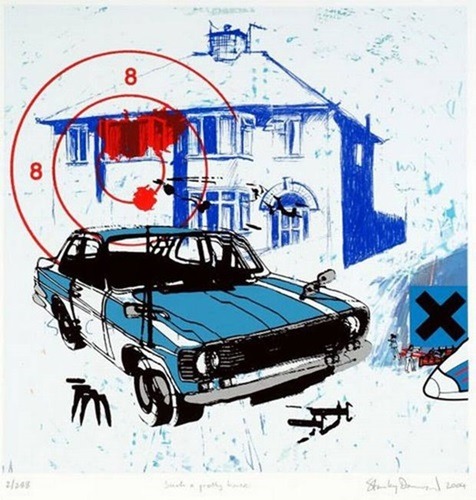
Such a Pretty House - Stanley Donwood

Perhaps my most personal image I have taken. An unassuming end terrace house on Desborough Road, in the fairly quite area of St Judes. This, is where I first moved to Plymouth in 2007, and where I lived when I started secondary school. This is the place where I first felt the feeling of alienation and being estranged from the people around me. It was here that I suddenly realised that I am not like the typical adolescent. I didn’t enjoy my time here, as I hated where I went to school, I hated the people at my school and I couldn’t understand why I felt to different to my contemporaries . Whilst everyone was more interested in boy bands, Blackberry phones and Helly Hansen jackets: I was concerned about the Financial Crisis and climate change. Behind the house is a train track, which many years ago used to run to Friary Station, but it now home to Friary Retail Park. When I lived here, it was used for shunting freight, and most days I would see and hear a British Rail Class 09 (known as a Gronk). You could hear it further down the line towards Prince Rock and would get louder and louder as it got closer to the end of the track. This area is a place where I very rarely visit, and only photographed it because I was around. I tend to avoid it mostly as it brings back that whole period of time, which I would mostly like to forget about. I hated that part of my life, and for that matter, most of my teenage years have been forcibly eradicated from my mind.
A coda. The Nikon F3 is the best 35mm camera I have used, and people who say gear doesn’t matter are kidding themselves. There is nothing better than using a camera that you feel entirely comfortable with, and want to take out and use. The F3 is made for using, and made for professional use, and for the photographer to have an easy and enjoyable experience. It has made me realise that (for the most part), I have been using crappy equipment in comparison: Why would I go back when I already have the best? Using this camera made all of the difference, and I feel that I am back on track to making some good work. Ilford Delta 400 is also a lovely emulsion, with a good level of contrast and grain for Ilford’s core shell crystal technology, utilising a tabular grain structure instead of the typical cubic grain found in other film stocks. The subject matters were also a hit, as I walked in areas that I am familiar with, but went down streets and roads that I haven’t been too in a long time, or never have been before. This would mean that I would wander down a street, look across a junction and think ‘lets go there’, instead of having a set route planned in my mind. This utilises ‘dérive’ as much as I can, as I drift from one urban area to another. I enjoy this as I can get to locations at random, and the thoughts and feelings I get from them are always a surprise. I never go into a space expecting to feel a certain way, so having to ability to decide entirely where to go is a luxury - perhaps this is why I feel the need to document gates that you can’t open? All in all, I am extremely happy with this shoot, and if they are all like this from now on, I shall feel optimistic about this leg of Epochal Territories.
Bibliography
Such A Pretty House (no date). [Online]. Available at https://www.artcollectorz.com/artworks/artwork-detail?artwork_id=6466&edition_id=8191. [Accessed on 10/11/2021]
0 notes
Photo
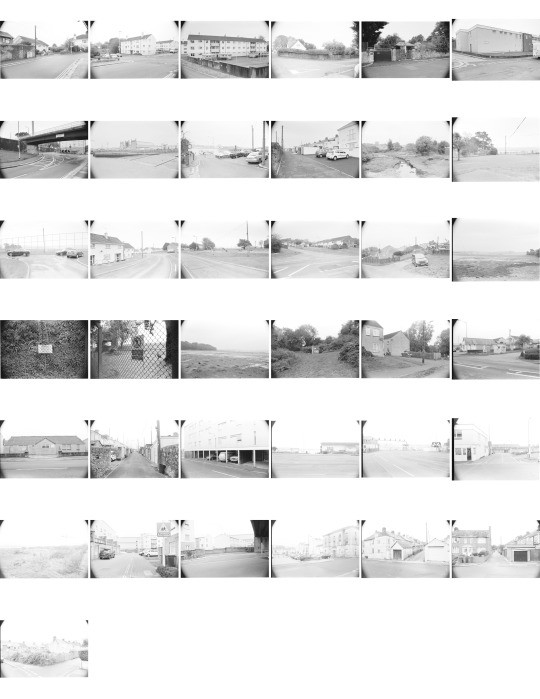
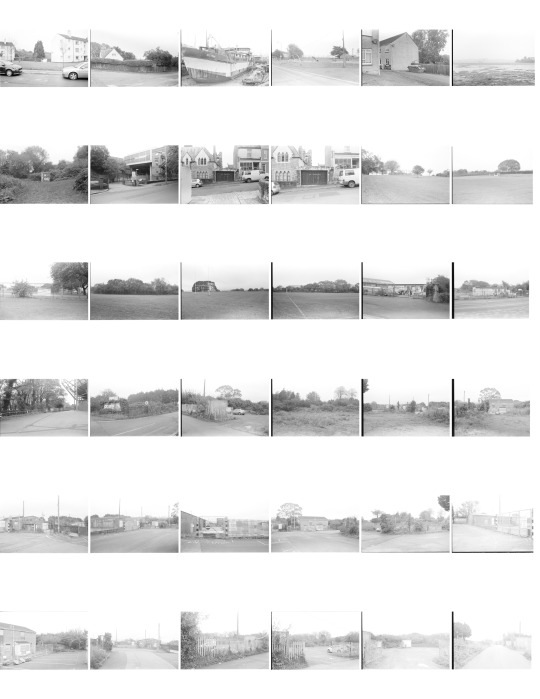
201 - Epochal Territories - 19/26/10/2021 - Shoots #2 & #3
Sometimes, things do not go to plan as much as you make it up in your mind. Most of the time, shoots go rather well, with equipment working, no issues with location and when they’re developed and finally scanned, everything in the world is well. This was not one of those times.
I wanted to get further afield from Plymouth by foot, as the locations I would photograph, I already have documented. My idea was to walk to Torpoint, around and then back during the day. This part, went well. And so, on the morning on 19th October, I walked from my flat, across Plymouth and boarded the ferry at Devonport, bound for Torpoint. In terms of walking, it was great. In terms of photography, it was lacklustre.
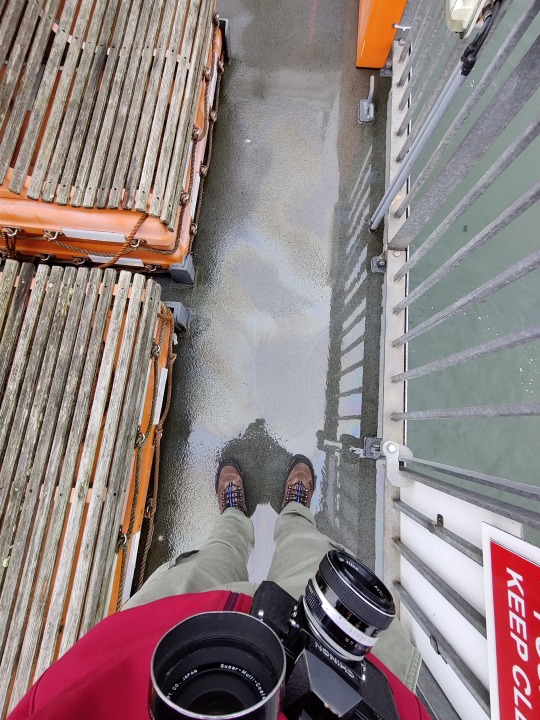
On the ferry to Torpoint, stood in a rainbow.
I took two 35mm cameras with me: the Pentax S1a paired with a Super Takumar 28mm F3.5, and a Chinon CE Memotron with the Tamron 35mm F2.8. During the time of shooting, there as nothing untoward with the process. Upon developing was when the issues raised their heads. Firstly, it took me about an hour to put both rolls onto the reels because the ball bearings on the spools were grabbing the film. Secondly, the lens hood on the 28mm was too long for the lens, and I couldn’t see that through the viewfinder, so it left some heavy vignetting on every frame which can be seen on the first contact sheet. Although thankfully, this roll was finished on the 19/10/2021, but the Memotron roll was finished on the 26/10/2021, creating another shoot.
I initially wasn’t feeling the 35mm focal length for some unknown reason. And after developing and scanning, realised that all of the images are affected by a camera fault, with each left frame coming out of focus instantly, which meant that I had to crop all the scans from that roll. I haven’t had this issue with this camera as of yet, but I think it is down to the pressure plate not being completely flat. And to add insult to injury, lots of the images missed focus. All in all, a dreadful turn out.
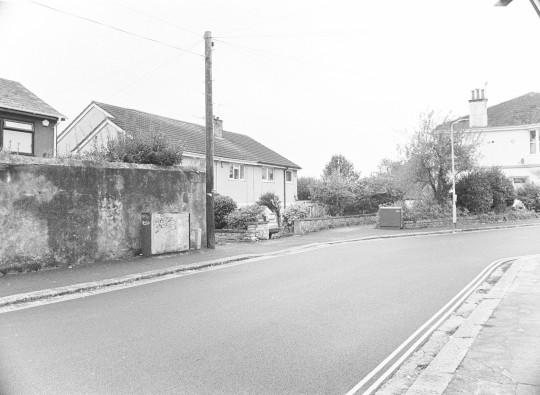
Whittington Street. A collection of council properties just off of the main drag leaving, or going into Plymouth. Nothing spectacular here, just the typical suburban scenes we usually inhabit or travel through.
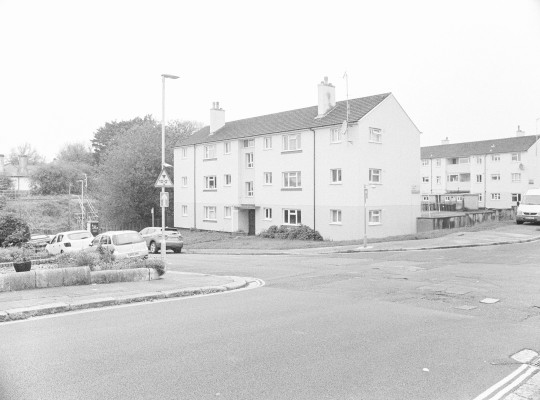
Rows of council flats on Wingfield Road. Mostly identical buildings are upon this road, all with different names to differentiate themselves from each other. Typically, they are split by an outdoor area featuring bin stores and washing lines. I was very aware of people watching me in a lower class area, who are typically not to kind towards people point cameras towards their homes. The road opened up to a vast expanse of these flats, mostly featuring box rooms and road parking.
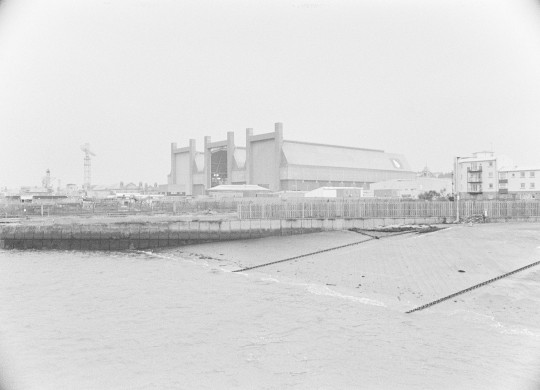
The docks at Devonport. Three large structures where warships are maintained and nuclear subtances are handled. This is where the 11am Monday alarm blares from, which all Plymouth residents are acclimatised too. Warships can be seen within the frame, and offer a guide to the size of the Dockyards themselves. These hanger-like structures aren’t the only kind to house such vessels, with dry docks further north of this.
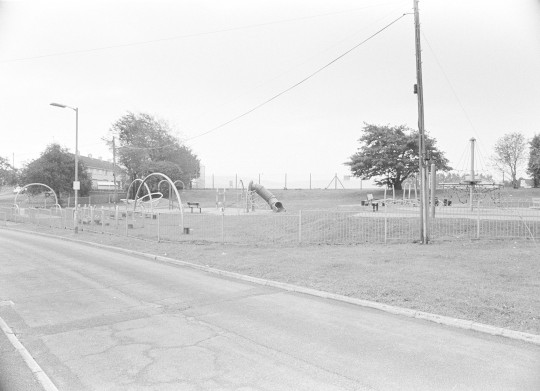

Something I found off putting in Torpoint, is directed again at the military presence around the town. It is a reoccurring theme with Epochal Territories, but I think it is only natural seeing as the South West has the highest quantity of soldiers in the region across the country. I had a photograph in mind, as right on the perimeter of HMS Raleigh, is a child day care centre on the entrance of the site. I was about to frame up my Pentax but I saw about 20 soldiers, all in MTP with blacked out Ford Focus’, and decided to not take my chances. Even more unsettling was the sound of gunfire in the distance from the range. The houses surrounding the base are also of a similar design of those I documented at Azimghur Barracks in Wiltshire last year. I immediately felt uneasy, and made my escape through the housing estate and by the playground above.
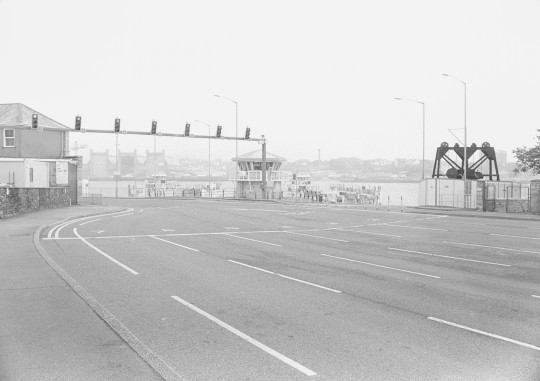

For the first time, I used the Hasselblad Flextight X1. After four years of scaremongering about their reliability, I finally used one. And, to my surprise, its the easiest film scanner I have ever used. The detail (even on 35mm) is incredible, and for the file sizes, surprisingly fast. I scanned each roll at 3000PPI, and with some adjustments, they look beautiful. Far far better than my Canoscan 9000F MKii. The scans are incredibly flat in tone, and really pick up the grain structure of each frame. These are highlights of this roll, but I won’t talk about each image as I usually do because there are two rolls to talk about here. Speaking of which.

This is one of the only images from the Memotron in Torpoint that I like. Despite the mass cropping (which you can see how much via the contact sheet), the framing works well here and isn’t too claustrophobic. I find these residential areas rather peaceful. This is were people tend to live their lives, so you can get a personable experience from them, without anybody actually being within the frame. You can also get fallout from their activity such as a skip filled with household waste.
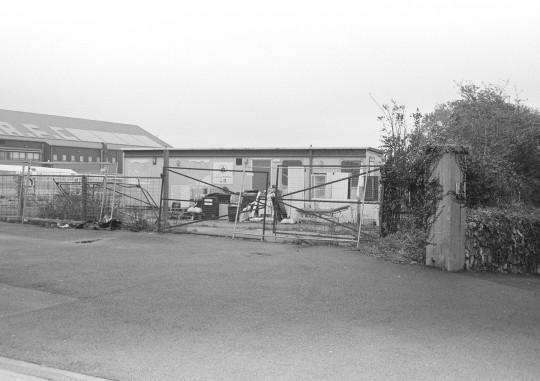
Right outside the PAFC grounds, a cordened off area filled with desks and chairs from what I suspect to be local offices. I was excited to see these image on film, but due to the camera fault and the heavy cropping, I may have to return at a later date to capture what I saw in my head, and through the viewfinder.

Previously the Royal Mail depot, it is now owned by University of Plymouth after major refits and maintenance. I am not entirely sure what is taught here, but it is an impressive structure with a large loading bay, parking and grandiose architecture. There is also a road behind the building that runs adjacent to the mainline, which I have walked up previously to no surprise, a feeling of not being either welcomed or allowed to do so.


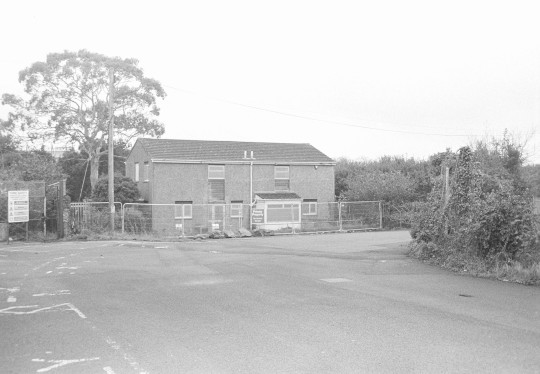
One area I would like to return with a better camera, is just above the PAFC grounds, with this abandoned building and parking area. Once utilised for council vehicle and bus maintenance, now stands unloved and overgrown. Similarly to Torpoint, I got the feeling that I was being watched, and that I shouldn’t be hanging around the area too long. Every time a car came in and out of the car park for Goals Plymouth, I thought it was going to be someone to remove me from the area and stop prying eyes. From what I can tell, it has been left for many years, and doesn’t seem to be going anywhere. The vast wasteland of edgeland used to serve as a car park, but has seriously become inundated with all kinds of weed and bush.
Drifting from place to place (Dérive as Guy Debord coined) is an interesting concept to apply to photography. I get to reflect about how the space makes me feel, whilst simultaneously documenting alienated landscapes where people aren’t present to make the viewer feel as alone and solitary as I do when I am on location. These photographs are meant to serve a few purposes: Document a man-altered landscape at our stage of late-capitalism, critique and question said stage, and reflect upon how the stage we are in is withdrawing our interaction with people as we become more digitally connected. This body of work is highly influenced by the New-Topographics movement, and the photography of Lewis Baltz, Robert Adams and Stephen McCoy. But I think it is time to find a new term that fits itself at the particular stage we live in. New Topographics was created at a time when photography was slowly becoming an art form, with at the same time, the landscape of America changing as capitalism grew, and so did consumerism. In the name of the system and money, the ‘natural’ landscape was altered to make way for car parks, shopping malls and motorways. This meant the topographical landscape was for them, new. Now, we have inhabited these landscapes for 50+ years, and it is something we’re use to seeing and being a part of. I propose that these contemporary landscapes are called ‘Post-Topographics’. These landscapes are no longer ‘new’, and the speed of which we progress has slowed significantly, and argued in Fukuyama’s 'The End of History and the Last Man’. We have surpassed the 'new’, and entered the 'post’ area of topographical landscapes. These have seemingly created further urban environments and also created the edgeland; an area of grassy, woody nothing somewhere on the outskirts of a town, mostly found under raised motorway sections and on the cusp of the countryside. The 'post' has paved the way for our comfortable nature with these landscapes, including sprawling suburbia, retail/industrial parks, shopping centres and multistorey car parks. We have acclimatised to these urban structures to the extent that they've become our natural habitat, which is only reflected upon once we're removed from that space, and placed in a 'natural' environment (this is quoted because the natural we know isn't that, as it's been altered by man for hundreds or thousands of years. Those hedgerows separating fields aren't naturally made). What we see in those edgelands, is nature trying to reclaim it’s own land back by sprouting buddleia and Japanese Knotweed, as it clambers to man-made structures such as walls and garages.
A coda. This excursion wasn’t as successful as I wanted it to be, and mainly ended up being disappointing as the end results were fraught with technical issues and lacklustre exposures. Perhaps I put too much pressure on the journey and wasn’t all that into it, or that my head wasn’t in the right place. Failing that, it could just be that the locations weren’t that great in the first place. There are useable images to be had, just not as many as I originally wanted. This is certainly better than none at all, or having a complete technical failing. Hopefully later excursions will be a lot better.
0 notes
Photo
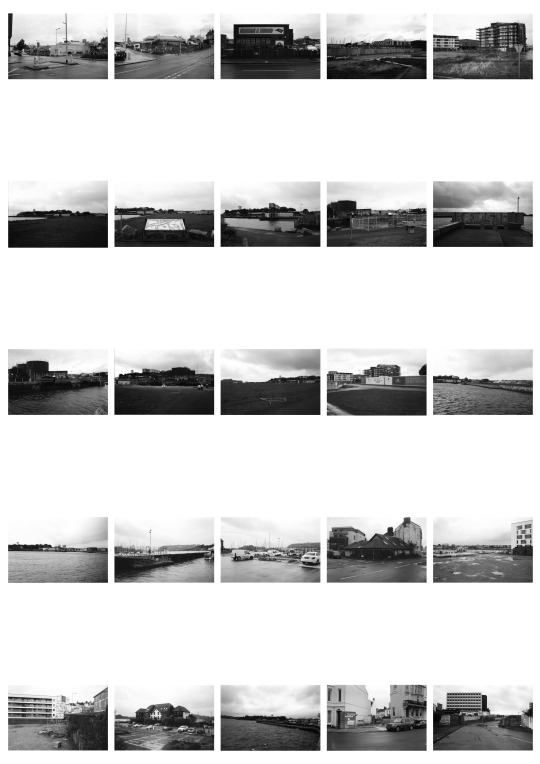
201 - Epochal Territories - 28/9/2021 Shoot #1
The time finally arrived to commence shooting for the next iteration of Epochal Territories. The departure of medium format and inclusion of 35mm was strangely welcomed. The increased detail of medium format is always welcome, but it is wasted once it is rendered digitally and compressed for web use. 35mm also features a more economical way of shooting, giving the photographer more frames to utilise - either to get wrong or right. This shoot wasn’t intentional, it started as a walk with a friend of mine, and I decided to bring along a camera loaded with film, just on the off chance that something would come along. What would come along was horrendously torrential rain and wind.
I brought along the previously shown Chinon CE Memotron, paired with a Tamron 35mm F2.8. The CE Memotron is a manual 35mm SLR, with the added ability of an early aperture priority system and a maximum 1/2000s shutter speed. For this time (mid-1970′s), this was ground breaking stuff. The 35mm focal length is one that I have warmed up to over recent years. I never used to enjoy it, but this focal length makes sense when exploring these environments, as a 50mm would be slightly too narrow, and 28mm can sometimes be too wide. The film of choice was Ilford HP5+, because of the films reliability and dependability. The roll was shot at 400 asa and developed in Ilford ID-11 at 1+1 dilution for 13 minutes at 20 degrees celcius.

The shoot started at Millbay, a location I had previously (partially) covered. The main portion of this brief walk went around Millbay Docks, which has changed over the course of time. Previously, it was a bustling dockyard and situated a soap factory which manufactured Millbay Soap - nationally revered throughout the mid-1800′s. The area is also known for its somewhat seedy, scrupulous and sexual doings, being ubiquitous for ladies of the night when the street lights turn on. It is also home to Plymouth Pavilions, which houses numerous live music, comedy and play acts which opened in the early 1990′s. This lays upon the site of the Millbay Railway Station, which was attached to the main line which ran through where the Toys R Us building is now situated.

Walking towards the docks means walking on Soap Street, named because of the aforementioned soap factory. A lot of the area is under redevelopment, as if Millbay is trying to turn a new leaf and attempting to undo the history of the area. Highrise flats are being erected whilst million dollar yachts float upon the dock. Yet around the corner prostitutes roam the streets, homelessness is rife and drug use is a daily occurrence. Above is a disused car park, blocked off with cones and concrete dividers, Yacht masts whistled in the wind as the weather decides to not make its mind up. The atmosphere was still - unlike the wind - with minimal noise apart from the workmen on said yachts. The light was thankfully diffused due to the cloud cover, with minimal shadows making the landscape bleak and tumultuous. The flat light renders the space very matter of fact and deadpan, but it also makes the image seem uneasy and still.

A view of the sound was spoiled by this concrete block, adorned with graffiti and relevant signage. The light became more subdued and even makes it seem underexposed. I feel this makes the environment more bleak, and plays upon the weathered and graffiti’d concrete, which seems to be weathered by the constant sea battering. I also chose to shoot this straight on, instead of at the typical angle seen across my body of work, to keep the composition straight across the horizontal and vertical lines. It also makes it seem more topographical, as a study of the urban landscape, which is what I intend.

Looking back at Soap Street gives more context with the redevelopment of Millbay. The direction is pointing towards making Millbay a ‘waterfront district’, obviously for people with a certain level of wealth and not the layman, which is aimed to a certain class of person. These are privately owned properties, either sold or rented a premium for those that can afford it, for the small bonus of a sea view, and the occasional view of the Brittany Ferries services to and from the continent. Even though this redevelopment isn’t finished - more akin to a building site - you get the feeling that you either shouldn’t be here, or don’t belong here. I feel that both are credible, as you shouldn’t feel comfortable walking around a building site when one isn’t meant to be there, and once finished depending on ones social class, might not be able to feel welcomed, this becoming alienated from the environment.
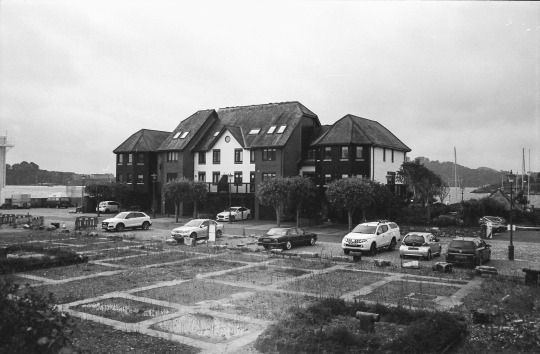
Millbay Marina Village is home to the management to the berthing at Millbay and private car parks. As prestigious as multi million dollar yachts, private car parks and 24hr security sound, the car park seems to be run down, dilapidated and overgrown. Further to the left, is also the Plymouth Life Boat station, which is crucial for those at danger on the sea - not to mention the thousands of shipwrecks that lie just within Plymouth Sound alone. Even the building for the site is verbose, but also looks as if it should be situated in the middle of a city as a council building or municipal collective.

After being drenched and taking cover in a cafe, to dry off and have a cup of tea, we braved the September storm for a final push, with this shot taken adjacent to Brunel Way and looking towards Ballard House, one of the main council offices for Plymouth City Council. Ballard House features a beautifully designed brutalist architecture, which is typically 1970′s in design. The bare concrete and rounded windows are dead giveaways to that architectural styling, often hated because of the bare concrete and often dystopian designs. It is strange to think that the socialist east and capitalist west at the time of the Cold War were using the same architectural styles, both coming to signify each of the east and west divides. It is known that Plymouth is rife with Brutalism, notably the Civic Centre and Theatre Royal. I wouldn’t count buildings such as Pearl Assurance House, as they are made from Portland stone and not Beton Brut. Ballard House seems to stand proudly over Millbay, and towers above the detritus that is Millbay. Just as Brutalism is, the area is dated, stuck in the past, hauntological. Millbay seems to have a lost future of nautical pasts and industry, and maybe even alienated from its past and unknown about its future. It cannot shake the stereotype it has created, and it probably never will - you can’t polish a turd - but only time can tell.
A coda. Shooting (properly) has started, and is off to a seemingly good start. I am enjoying going back to 35mm and having the freedom of more photographs per roll, and the ability to use my own cameras and lenses. I am also enjoying juxtaposing the norm of medium or large format photography in landscape photography, and taking on a more quick and dirty approach similar to photojournalism. In a sense, I am documenting, surveying and creating a journal of photographs of the urban landscape. The main aim for these environments is to feel estranged, not welcome or on edge. There has to be something about the environment which makes me feel not welcome, or looking at the landscape in such a way that I become detracted and removed from the space, which is mostly done by spending too much time in a place where one shouldn’t spend time in. The CE Memotron was also a great shooter. This was the first roll I have properly shot and developed through it, and they were all taken on the aperture priority mode, with the lens stopped down to F8 to F11 the maximise the depth of field. Despite it working, the scans were a tad dark and were adjusted in Lightroom. My Canoscan 9000F MKii isn’t ideal for 35mm film, and only really shines as the film becomes larger. I think I should utilise the Hasselblad Flextight for final scans, and keep the Canoscan in use for these posts to roughly show how they turned out. I plan on going on longer walks soon, but now that I have started a full time job, my time is restricted to Tuesdays and weekends for shooting. I would like to go further afield and spend most of the day ‘on location’, with maybe multiple cameras and multiple rolls to maximise my shot count. Two cameras can also have different lenses (35mm and 28mm) to save changing lenses. This can only been seen in practice, which I shall try and do on my next adventure, which I would like to call non-place rambling.
0 notes
Photo

201 - Epochal Territories - Spanning from Previous Ideas
This stage [201] of Epochal Territories is still very much in research and development. The boiled down premise of this stage is to somehow expand from the stellar results of 101, with this being particularly difficult. I have to somehow surpass the seemingly unsurpassable in order to go ahead and achieve more. Perhaps I have bitten off more than I can chew at the first hurdle, dug myself a deep hole and threw away the shovel.
Once boiled down and gently simmered, the idea is to turn away from the clinical, sterile nature of medium format, and return to a smaller format with less resolution, more grain and contrast. The added element of flash photography will also introduce a level of harshness to the light, depending if this works under experimentation. This idea stems from the ideology of photojournalism and documenting a certain story. In a sense, I am a photojournalism because I am trying to find and vocalise a certain story and a certain subject matter. The usual slew of photojournalists photograph celebrities, notable people, exciting things in life that don’t happen every day, or even obscene scenes such as traffic collisions or riots. My spin on photojournalism is to document the everyday spaces where man has visited and taken their stronghold. It is about finding these spaces which are part of our everyday world, never given a second glance but placed in front of us with photographs with nobody else in shot. The images gives one a sense of dystopia, almost as if we are the only people around within the landscape with nobody else to see, speak or relate to. These are the feelings that capitalism can create to a certain individual, making them alienated and estranged by not fitting in, not relating to those around them or not agreeing with how we live.
These spaces are found on foot, by walking and walking until the space presents itself and you get a feeling of overwhelming ennui and listlessness: You start to feel uneasy, almost as if you shouldn’t be here and you need to make an escape. You begin to feel trapped and you start looking for an exit, only to find you come out where you came in. You start looking over your shoulder to make sure nobody is watching you, or that anybody is following you as you can feel eyes burning into the back of your skull or close circuit television cameras recording your every move and kept on a hard drive for 30 days. You exit and the feeling of breathlessness leaves you, and you can finally breath in the unfiltered air with wafts of miasmic Biffa bins, dog crap and burnt rubber.
That might sound like a dystopian world painted from the imagination of a science fiction writer, but it is how the non-place can make one feel in addition to how late capitalism/supermodernity can. My photography is a way to paint our apparent utopia in such a way that it is seen as a fictitiously disguised dystopia. It is a way to highlight our way of humanist slowly fading as we become more calculated and robotic. Our lives are more and more ruled by technology, we are tracked 24/7, we are eavesdropped upon with our phone calls recorded for training purposes only. It brings into question our relationship with technology, and questions if we control it, or does it control us? Cancer rates rise dramatically, overpopulating increases, housing is few and far between, the cost of living increases and we become more reliant on a digitally connected world, which only makes us more disconnected with humanity. We are more robot than we think.
Taking a quick side not from the rabbit hole. The reasoning for stepping away from medium format and into 135 [full frame] is because of the increased simplicity, less reliance on modern technology and increased fallible nature. A manual 35mm camera is a tool the vast majority of photojournalists utilised in the past. They were experts and knew exactly how to use them, and didn’t need fancy metering, thousands of focus points, blistering burst modes and 512,000 ISO. In a sense, it seems more conducive to simplify the gear with as little distractions and bells and whistles. The camera is a tool - a box with a hole - and it all depends on how it is used. The 35mm camera is also a statement; a statement of rejecting certain aspects of modernity and embracing a process that requires attention, knowledge and expertise. It needs to be told what to do, instead of the camera being the smartarse - you need to be the smartarse. You cannot rely on P mode to calculate the exposure triangle for you. For the purpose of Epochal Territories, the 35mm camera is a way to juxtapose modern technology creating a hauntological present. Bringing into question when the photograph was taken and fictitiously making the viewer think it is from a different time.
Below, are a few images I took in January 2021 whilst testing a new-to-me camera: the Zenit 130. In addition to the main post image:

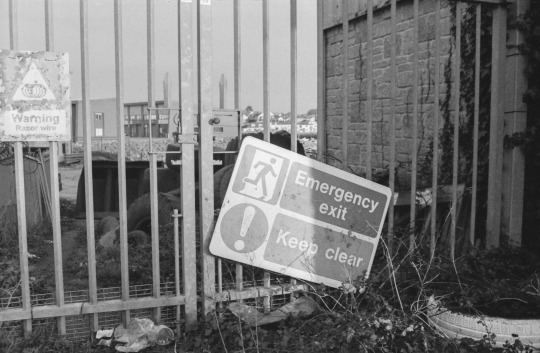

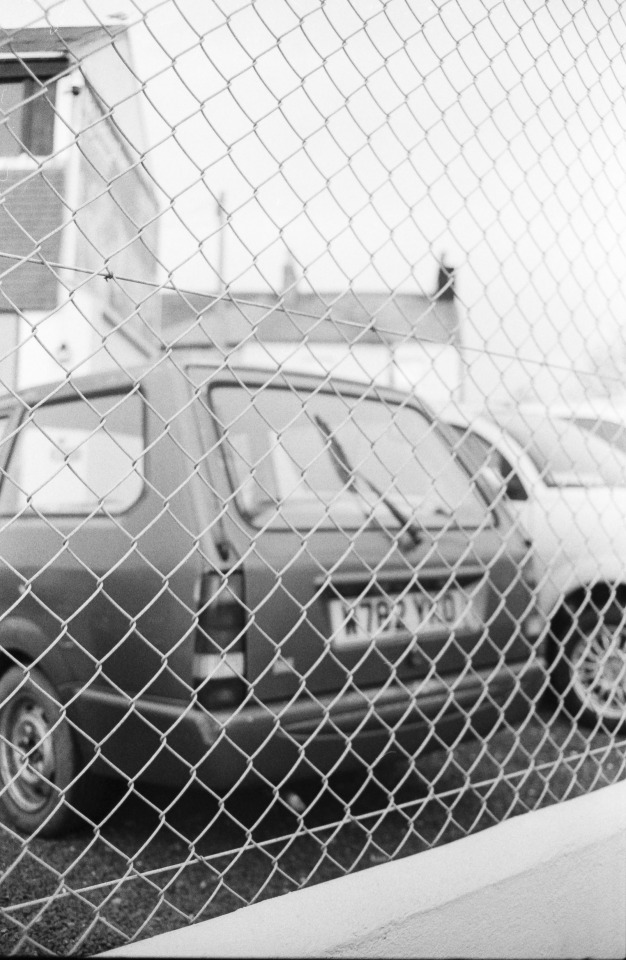

These were taken on a freezing January afternoon, testing a rare model soviet camera. Unknowingly until now, they were a prerequisite to what I intend to do now, which is documenting the non-place with a 35mm camera in B&W. Of course, there is no flash use but there are deviations to my usual style by including closer detailed photographs, rather than the topographical style of urban landscapes. Nothing was intended for this roll of film apart from making sure the Zenit worked OK, but in retrospect it is a way of working which I thoroughly enjoyed. It was at a time when the first leg of Epochal Territories was well underway and it was a departure from the pressure of the main body of work. It seems ridiculous to make this style of work the main area, thus placing that pressure on top of it, but it would also mean I have space to breath with shots per roll (36 instead of 10), and I can be more creative by developing my own B&W film, as I have a stash of slightly expired Ilford films that need using. I also have a large stash of darkroom paper, where I can experiment in the darkroom and create prints for a potential exhibition towards the end of the year. it brings up the point that it is September and I need to start working. The summer is a horrid time for me to work.
Everything is seemingly heading in the right direction. I plan to start shooting within the next couple of weeks once I have time and the seasons shift, with the light becoming easier to use. I shall experiment with flash also, but I am not entirely sold on the idea and sceptical that it will even work. Rest assured, all will be fine and all of the jigsaw pieces will fall into place.
0 notes
Photo
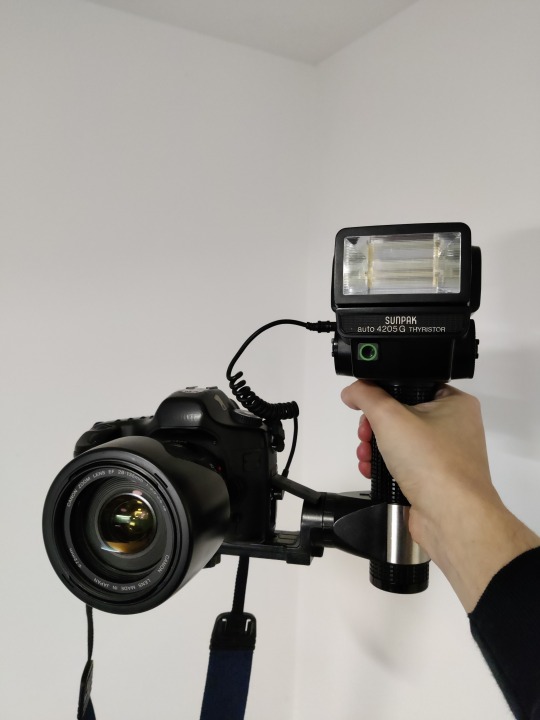
201 - Epochal Territories - Sudden Epiphanies of Direction
The previous posts have discussed my inabilities to produce work over the summer work due to a drought of creative juices. This happens year after year and now matter how I try, it keeps happening despite preventative measures such as digesting photographic work, philosophies, music and the like. Autumn comes around and I have nothing to show for the summer months apart from some half-arsed attempts. Yet, I had an epiphany that came over me like a tsunami.
A lot of the photographers I look up to and admire shoot mostly large format, with 4x5 or 8x10 view cameras. These are brobdingnagian compared to the usual formats that I have used in the past. The photographer has complete control over all aspects of the exposure, even changing the focal plane, shifting the focus and even the perspective. Field cameras are always stuck to a tripod and can only take two images per film holder and require patience, consideration and skill. I have these qualities - as all photographers should have - but do I really need to use these formats to be considered a photographic practitioner? The vast majority of working photographers are handheld, especially digital shooters for press and media with maybe sometimes on a monopod. After having a big think with a green tea, my mind found something that aroused my interests.

My body of work is exploring the non-place, and documenting what I find in a style similar to photojournalism and documentary photographer. This is due to me nature of walking to places and finding things instead of planning and waiting. It then hit me that I should take approaches similar to photojournalism and reportage and acting on a ‘run and gun’ style of shooting, partly inspired by the quick and dirty style of reportage with harsh contrast, flash use and close ups. Can there be a way that I can meld the reportage style of photography with my new topographical photography style?

Flash photography is something I know not much about. It is an area of photography that I have neglected because I haven’t had a use for it, but now I might. I own this rather large Sunpak Auto 4205G, which is a hammerhead style flash similar to Metz flashes. These are off camera flashes which offer a huge amount of light and flash head movement to bounce it anywhere the photographer wants it. On full power, it is incredibly bright, even rivalling some studio kits. As it is also an older flash, I was concerned about the flash voltage output as I would like to practice digitally before I would eventually go over to 35mm B&W film. Many old flash guns are encroaching on 250v which can easily brick a newer digital camera. After some digging on forums and websites, the 4205G is hovering around 6.5-7v which is safe to use on my 5D MK1, which is rated to 250v at the PC sync port and 6v on the hotshoe. Above, it is attached to a Chinon CE Memotron which could be a contender for the 35mm B&W workflow. This is due to the large array of lenses I can use because of the M42 lens mount, which ranges from 28mm to 200mm offerings in my collection. It also matches the aesthetic of press photographers of the time, apart from the fact most used Nikons. The 4205G is also a decently versatile flash, being able to be used at 1/64th power on manual mode. There is also a handy automatic feature which changes to power to the selected film speed an aperture, which affects the power output and the maximum flash distance. The flash is something I may try and incorporate in either the further distanced subjects, or to bring in closer subjects and isolate them with the flash.
With all of this in mind, how can it be tied together? My initial thoughts was (noted in my book above) would be to create a photo book in the style of a newspaper, featuring my photographs and writing. I am unsure at this stage what the writing could contain; they could be my thoughts and feelings of being within the space, and describing how these spaces play upon my mind. Yet, I also have to think about how to outwardly face this project. I could collaborate with someone to have articles featured within the body of work, or work with someone in the outside world to get it created. These are things that I have to think about, and fairly soon as September is just around the corner.
In the mean time, I shall experiment with the 4205G with my 5D to see how the visual aesthetic works with the everyday banal landscape, and if it would be worth moving it to a 35mm workflow. Either way, I would like to shoot this format again because of the photojournalist influence, and to economise my shooting. I would have the ability to shoot 36 exposures in a single go and I can afford to make a few mistakes along the way. It would also mean that I can develop at PCA for no cost, get back into the swing of developing my own film and utilise the darkroom to create prints with the extreme amount of photopaper that I have procured over the years. I do also have a large amount of expiring B&W film in my freezer which does need using up, so there is also costs cut in the direction too. I would also disregard my flatbed scanner which is my usual form of scanning too, purely because the quality it provides on 35mm isn’t all too great. I would like to inducted to use the Hasselblad Flextight scanners to greatly improve the quality of the scans, which would be unrivalled compared to flatbed scans. All there is to do now is to crack on, and push myself outside of my comfort zone.
0 notes
Photo

201 - Epochal Territories - Where Does the Path Lead?
The previous post detailed my doubts and worries about creating during a period of the year where I am creatively dried out. During my BA, this was completely fine as the months throughout June, July and August were free for us to do what we pleased. But, with the MA, we are expected to be creating all through the summer months before we come back in the Autumn. This is my main bugbear because those months are usually filled with nothingness in terms of photographic creations or reading. I have certain ideas and thoughts going around in my head, but nothing is really done about it.
201 is a forward facing, publicly aimed project. It is meant to be a body of work that sets it sights towards the public, whether this is via an exhibition, working with companies/charities, collaborating with other MA students or externally. This brings up another bugbear of working collaboratively with other people. My creative practice is very much whittled down to myself and my own thoughts, and the prospect of working with other people with my own work brings up feelings of anxiety. I am not completely sure if I am up to working collaboratively with other MA students, of which I have had offers. My initial thoughts weren’t with collaborating, but with somehow externally facing the public via different means such as an exhibition or alternative methods.
Something I have always wanted to do is create a form of voicemail message where people could call, and they would receive the recorded message of an altered or digital voice mixed with electronic ambience. This is mainly inspired by Radiohead’s How am I Driving EP which had a number you could ring on the back of the CD which was just Yorke saying ‘Hello?’, and callers could leave a message. Later in 2016, before Yorke released Anima, various strange posers appeared on London Underground trains and advert boards across the world asking people if they’ve had strange dreams, with a number attached. You could call the number and it would explain that Anima Technologies in under investigation for flagrant activities, and a stripped down version of Not The News would play. This was a strangely ominous and sinister way to promote an album, but I couldn’t help but love the idea of having a number people could ring and they’d receive a strange message or automated text replies, which the number for Anima did.
But how does this fit in with Epochal Territories? The potential phone number could work in a sense of listing off various symptoms and paranoid thoughts the caller may have, but are in fact my own - they may or may not relate to them. This could also work with a website in a similar fashion, with the website being stripped back with minimal information or even a survey listing similar thoughts and feelings. This was quickly scribbled into my notebook.
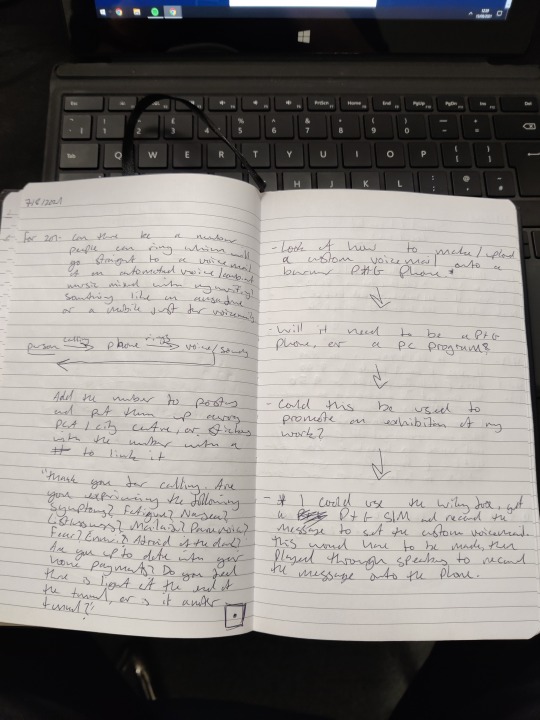
The recording of the message is the part I stumble at. It is something that I would need to research how to do, but my initial thoughts would be to create the message on sound editing software which can handle voice recordings, text/speech and music files such as Audacity. This could then be mixed together and played through speakers to record the custom voicemail message on the phone. The phone would just be a pay as you go sim placed into an unlocked phone (which I have) which can be turned off, which will let the caller go straight to voicemail. This setup could all be used to promote an exhibition, or my work in general. Posters could be placed across PCA or the city centre with the phone number or a QR code which would direct to the website.
In terms of Epochal Territories as a project, it is still on course from where it left of: exploring the non-place and understanding the relation between the place, capitalism and alienation. Now that the country/world is opening up bit by bit, I would like to explore various locations across the southwest. On my travels across Devon and Cornwall with family and through freelance work, I have seen interesting locations in places I wouldn’t have thought about initially. I would also like to use out of date A-Z maps and explore locations that might not exist, in a form of hauntological psychogeography. Hauntology is an aspect I am still interested in, and I would like to implement it again into my practice. The philosophy of the past haunting the present, and the lost futures certain spaces could have had ring true, especially in areas where they’re being renovated or demolished.
The saving grace is that there is plenty of time to think, read, create and hone where Epochal Territories is going before the deadline in January 2022. I am at the stage where Epochal Territories is gearing up for the FMP of 301 next year. This is again difficult because the end result of 101 was of the calibre of a 301 delivery.
0 notes
Photo
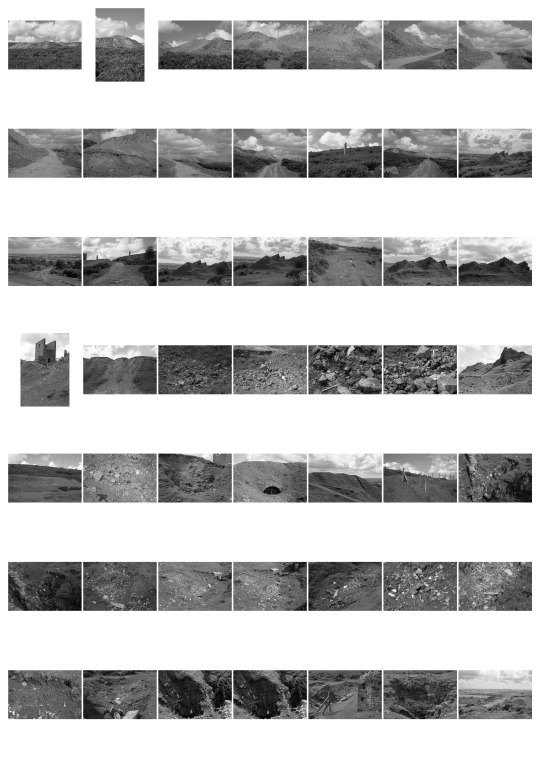
201 - 8/8/2021 - South Caradon Mine
Four months have past since the I shot the last images for 101. For perspective, that is 1/3 of a year, which is a hell of a long time to have shot nothing but commercial work over projects. It also doesn’t help that each summer, I have a creative drought due to the harsh constant sun and the hotter conditions over the summer months. This means that each summer, I photograph little to nothing in terms of my own practice and fall into a slump where inspiration doesn’t thrive and have to pick it up again when the sun lowers, the light diffuses and the temperature lowers. This is always difficult, and usually ends up with myself questioning what it is that I am making, and having the inability to create.
I don’t really know where I am at, with my practice, 201 and what it is I want to create. The feedback from 101 was something that blindsided me, as it was a lot better than I had anticipated and something that was expected of me in 301. How can I progress from the first module if it is something that is already outstanding? How can I improve on something that is already hard to surpass? Did I make too much? Have I set the bar too high to get over?
To try and curve these feelings, I borrowed a camera I intend on purchasing in the near future from a friend of mine. My Canon 5D MKi is lovely, but it is getting very, very old. Thankfully, I have a 5D MKiii in my possession which is a lot newer, but strangely is now the same as the MKi was when I got it. The sensor is newer, the megapixel count is higher, the screen is crystal clear, it can shoot video and last longer on a single charge. The MKiii is better in everyway possible. I took the 5D MKiii with me, coupled with the 50mm F1.8 STM and a Hoya circular polariser.
The start of August saw myself spending time with the in-laws in Cornwall for Harriet’s birthday, and we made our way to South Caradon Mine for a walk along the moors, a 19th century copper mine along the eastern edge of Bodmin Moor. This area is littered with engine houses, mine shafts and chimneys sprouting from the ‘natural’ moorland landscape. There is only so much natural land on the moors that aren’t slag heaps from 19th century mining. These can be easily discernible from the shapes, mostly layered with flat edges and trails of dirt from the top.

Something I had immediately found was, that I hate working in colour. I have been strictly monochrome for the better (or worse) part of a year, and seeing my images in colour that aren’t commercial were converted to black and white. All of the spectrum of colours just don’t work for me anymore, and converting them to monochrome made it easier to digest. This was just the basic low contrast pre-set on Lightroom and then edited depending on the highlights/shadows.
Firstly, a large slag heap looms over the footpath, at around 30ft in height - you can also see the Caradon Hill Transmission Station on the right side of the frame. I was interested in the way man had altered the landscape, and had Lewis Baltz in mind when walking around the luscious greenery marred by lurid slag heaps.
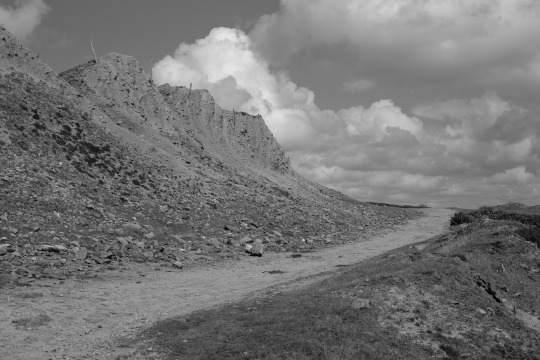
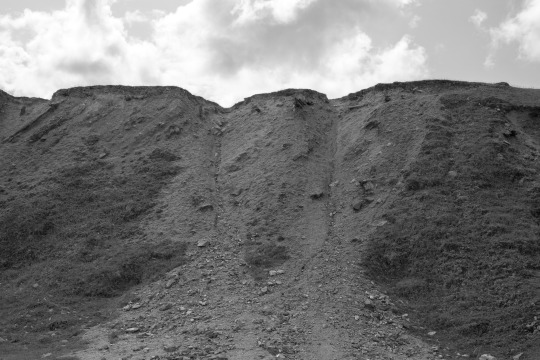
Taken out of context, the landscape could be anywhere on this earth, or not. The landscape felt rather alien compared to the rolling hills and bracken bushes as far as the eye can see. The mounds tower above the rest and serve as reminders of man’s past destroying the natural landscape during the industrial revolution, pillaging the land for any resources with fire, coal, smoke and harmful gasses - the theme of Epochal Territories’ difficulty to breathe still rings deafeningly in the ears like the blast in a mine shaft.



The surrounding landscape is also littered with remnants of our society, much more contemporary compared to the 19th century: Glass, buckets, tape measures, cotton, cans, bottles, asbestos, sheet metal, cups, toy cars - generally rubbish. Closer to the bottom image, is a mine shaft full of more rubbish, similarly to landfill but presumably illegally dumped. Things such as ovens, washing machines and corrugated steel. Speaking of the bottom image, it reminds me of the wreckage left after a plane crash, with the debris scattered across a large area with this gully acting as an impact crater where the imaginary plane had impacted the earth. The landscape is spoiled by industry, blown in litter and then intentionally dumped rubbish as wildlife and farm animals roam. It brings into question our relationship with our earth and how we got here. Why can’t I have a walk in the countryside without it being ruined by everyone else’s mess? How is it that everywhere I go, our rubbish still resides? How on earth did all of this shit get here? The nature of our world has brought us up to discard anything that isn’t useful instead of recycling or reusing materials or products. Our greed fuelled the destruction of our landscape, not that our forefathers cared about the landscape - they had profits to make, colonies to overthrow and countries to acquire like a game of Risk. Tonnes of toxins flooded the air as the mines churned out copper, the workers breathing in dust, smoke and radon gas.
A coda. This wasn’t a planned shoot, more of an impromptu walk around with Epochal Territories on my mind as the underlying anxiety bubbles beneath the surface, in the knowing that E.T needs to be worked upon since 101. This is more food for though and contemplating. It is placing the project in a different environment compared to the urban sprawl, it is in the moorland where these feelings of alienation from capitalism first started in the 19th century. We have progressed since then, but we have also gone far from reversing what we have done. Our environment is damaged, and it is too late fix. All of the plastic bags and toothbrushes we have ever used are still in landfill, or stuck in the sea harming wildlife. We have all caused this, and we can’t go back.
0 notes
Photo

Epochal Territories - The Photo Book
Making a photo book is something that I am attuned to by now, as I have been making digital and physical books since the second year of my BA, starting with Alienated Spaces for PHOT201. This was made via Bob Books and is available to buy on their site. This was my first experience of putting my work together in a setting which was more than just a few prints. It opened up a world where I could have a continuing narrative which my work gels with. From then on, I have created photo books for all of my submissions, with the latest few being wholly digitally because of the zeitgeist of COVID-19.
During the first lockdown, I created a few zines for Mileage May Vary which were work in progresses from the current work, and eventually ended up being a full digital photo book consisting of around 60 pages with informative text supporting the vehicle data of the project. The photo book is something that I wanted to continue, as my work does fit the theme of having a continuing narrative, rather than a select few prints. I found that my photographs work well in a series, which only furthered when they mirror my practice of photography.
Epochal Territories is a mixture of photographs, written word and graphical elements going along the theme of alienation and estrangement from our modern society. I knew the photographs would be able to go ahead on their own, but I wanted elements of my scrabbled notes within the book, in addition to digital, graphical designs to go along with that also, to mirror our technocratic and technology orientated society. This can also be seen with the writing emulating MS DOS command screens but with a more human element with errors and spelling mistakes.

Page 7

Page 8

Page 53
The layout of the book is entirely chronological, similar to how Alienated Spaces was laid out. My decision on this was purely because of the psychogeographical and flaneur inspiration, with myself wanting to take the viewer on the same journey I took with all of the photographs corresponding from the start of the project, to the end of the project. One can also see the progression of time through the images, from the end of autumn, start of winter, and then with winter transitioning to spring.

Page 16
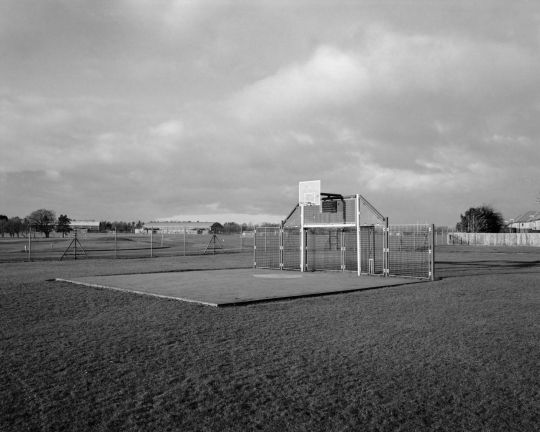
Page 22
Pages alternate from bordered white pages, to full page spreads depending on the contents of the photograph, in addition to keeping the book different, and not the same layout image to image. Each photograph was cropped to a proper 4x5 aspect ratio to keep a uniform shape, with the entire book being made in the same aspect ratio to keep it balanced.

Front Cover (Final)

Early Front Cover
The front cover was the easiest part to design. I had an idea in my head with what I was expecting, in such a way that would be minimal and stick to the monochromatic theme of the project. I knew I wanted to use Helvetica as my main font on the front cover, because of it’s simplistic sans design and history within graphic design. I chose to repeat the title and erase it partially to have a semiotic of erasing clutter in one’s life, as well as having a sense of panic and unease. The black border was brought in to balance page, instead of having the entire page being a photograph and potentially causing distraction. The photograph was also changed because of the improved leading lines and balance on the photograph.
0 notes